The San Francisco Bay Area is home to a diverse range of avian species, from migratory shorebirds and waterfowl to raptors and songbirds. With its varied topography of mountains, wetlands, dense forests, and urban landscapes, the region provides a rich habitat for birds of all kinds.
The bay itself, with its extensive network of wetlands, estuaries, and tidal flats, supports a significant number of bird species throughout the year, making it a vital stopover for countless migratory birds.
Whether you’re a casual birdwatcher or a serious birding enthusiast, exploring the many birding hotspots in the San Francisco Bay Area promises to be a delightful and rewarding experience.
1. American Robin

The American robin is a migratory bird, belonging to the true thrush genus and Turdidae family.
It was named after its European counterpart due to the similar reddish-orange breast they both possess; however, they are not related closely.
This species can be seen through most of North America during winter months, as well as in parts of Mexico and Central America where it also breeds.
They have plump bodies with gray upperparts and white underparts that vary from yellow on their throats down to orange toward their bellies.
Robins feed on fruits such as berries or insects like worms which makes them an important part of ecosystems by helping disperse seeds naturally throughout these areas.Scientific classification:
| Kingdom | Animalia |
| Phylum | Chordata |
| Class | Aves |
| Order | Passeriformes |
| Family | Turdidae |
| Genus | Turdus |
| Species | T. migratorius |
Also Featured In: Most Common United States Birds, Most Common Winter Birds
2. Northern Mockingbird
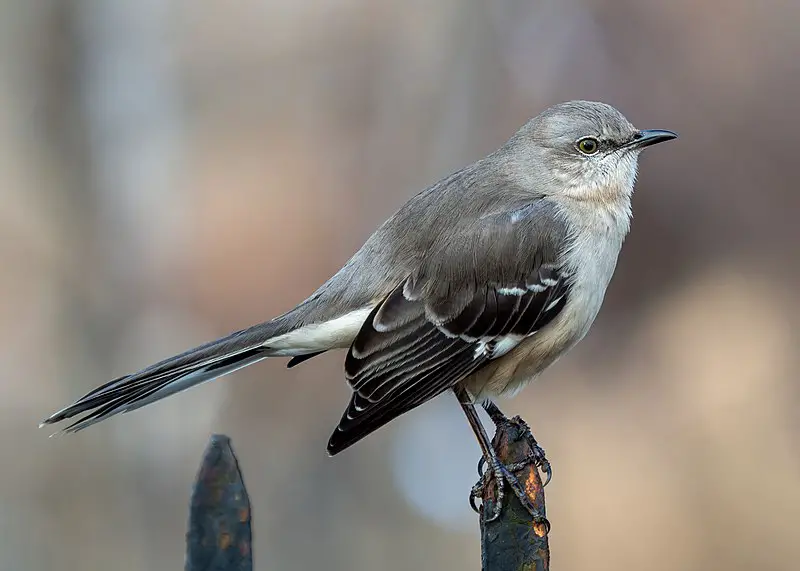
The northern mockingbird is a common fixture in North American skies. It has greyish-brown upperparts and a paler underside with white wing patches, and its distinctive long tail makes it easy to spot.
This adaptable bird can often be seen singing from the tops of trees or fences, though it rarely strays into Europe.
The species was first described by Carl Linnaeus in his 1758 Systema Naturae as Turdus polyglottos – aptly named for their remarkable ability to mimic other birds’ songs.
Northern mockingbirds typically live on insects, fruits, berries and seeds but they will also happily scavenge food scraps left out by humans.
With its beautiful song and striking plumage this beloved avian makes an important contribution to our environment.Scientific classification:
| Kingdom | Animalia |
| Phylum | Chordata |
| Class | Aves |
| Order | Passeriformes |
| Family | Mimidae |
| Genus | Mimus |
| Species | M. polyglottos |
Also Featured In: Birds that Live in Mississippi, Birds You’ll Find in Night
3. California Quail
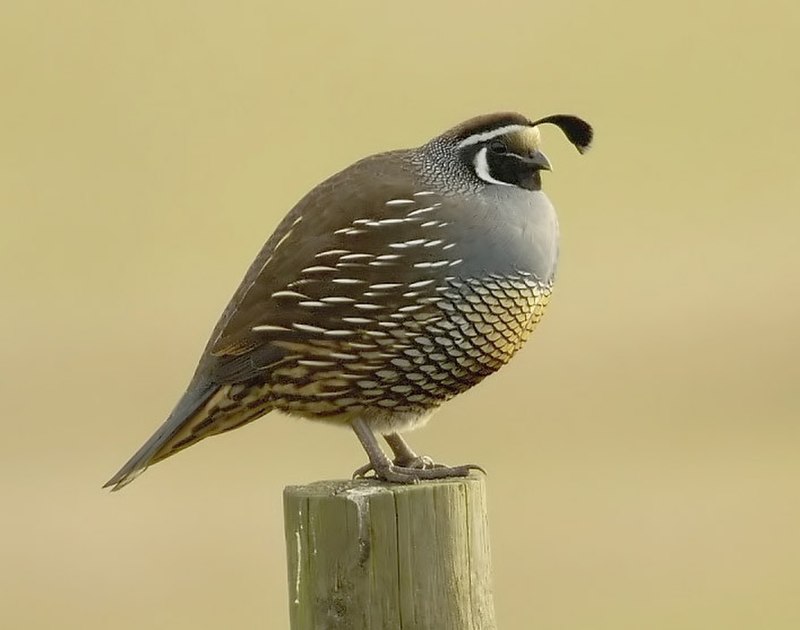
The California quail is a small, ground-dwelling bird with an iconic drooping crest. Male birds have a dark brown cap and black face while females sport a brown back and white streaks on their flanks.
These quails are found in the western United States and parts of northern Mexico and may gather in groups to feed or dust bathe together during the day.
Their diet consists mainly of grasses, seeds, berries as well as some insects like beetles or ants.
The population has been declining due to habitat loss so conservation efforts are being implemented for this species’ survival.Scientific classification:
| Kingdom | Animalia |
| Phylum | Chordata |
| Class | Aves |
| Order | Galliformes |
| Family | Odontophoridae |
| Genus | Callipepla |
| Species | C. californica |
Also Featured In: Hawaii Big Island Birds You Should Know, Small Birds of California
4. American Crow

The American crow is a large bird of the Corvidae family, native to most parts of North America.
It is similar in size and structure to its European counterpart, the carrion crow, as well as Eurasia’s hooded crow.
The three species occupy the same ecological niche, but are distinguishable by their differences in appearance.
American crows have black feathers covering their entire body with wingspan averaging between 17-21 inches wide for males and 16-19 inches for females.
They feed on insects such as grasshoppers, beetles and caterpillars; they also eat grains from fields or abandoned farms during winter months when food sources become scarcer.
In addition to feeding habits American crows can be identified by their distinct call which resembles a “caw” sound that travels long distances over open terrain making them popular among birdwatchers.Scientific classification:
| Kingdom | Animalia |
| Phylum | Chordata |
| Class | Aves |
| Order | Passeriformes |
| Family | Corvidae |
| Genus | Corvus |
| Species | C. brachyrhynchos |
Also Featured In: New Hampshire Birds You Should Know, British Columbian Birds
5. House Finch

The House Finch is a species of finch native to western North America and has been introduced in the eastern half of the continent as well as Hawaii.
It’s an average-sized finch with adults measuring 12.5 – 15 cm (5 – 6 inches) long and having wingspans between 20 – 25 cm (8 – 10 inches).
The upperparts are brown, while its underparts range from pale grayish white to yellow depending on subspecies.
Its face is streaked or spotted with reddish coloration; males typically have brighter plumage than females due to sexual dimorphism.
They’re mostly found near human habitations such as farms and gardens where they feed on grains, fruits, insects etc., making them very popular among birders who want something colorful for their backyard.Scientific classification:
| Kingdom | Animalia |
| Phylum | Chordata |
| Class | Aves |
| Order | Passeriformes |
| Family | Fringillidae |
| Subfamily | Carduelinae |
| Genus | Haemorhous |
| Species | H. mexicanus |
Also Featured In: Common Birds in the Cities, Common Birds That Live in Las Vegas
6. Dark-Eyed Junco

The Dark-eyed Junco is a species of small, grayish sparrows that are found across much of temperate North America and in the Arctic during summer.
It was formally described by Carl Linnaeus in 1766, who named it after its distinctive dark eyes.
This bird has a very variable appearance due to the many different subspecies it contains, making its systematics difficult to unravel.
The plumage varies from white or light gray on their underparts with slate grey backs and wings; black heads with white outer tail feathers; brown head stripes; yellow bills; pink legs and feet; as well as various shades between all these colours.
They also have considerable sexual dimorphism where males tend to be more colourful than females but share similar characteristics such as short tails and rounded bodies – both sexes being around 16 cm long when fully grown.Scientific classification:
| Kingdom | Animalia |
| Phylum | Chordata |
| Class | Aves |
| Order | Passeriformes |
| Family | Passerellidae |
| Genus | Junco |
| Species | J. hyemalis |
Also Featured In: Lake Tahoe Birds, Birds that Migrate through Illinois in the Spring
7. Mourning Dove
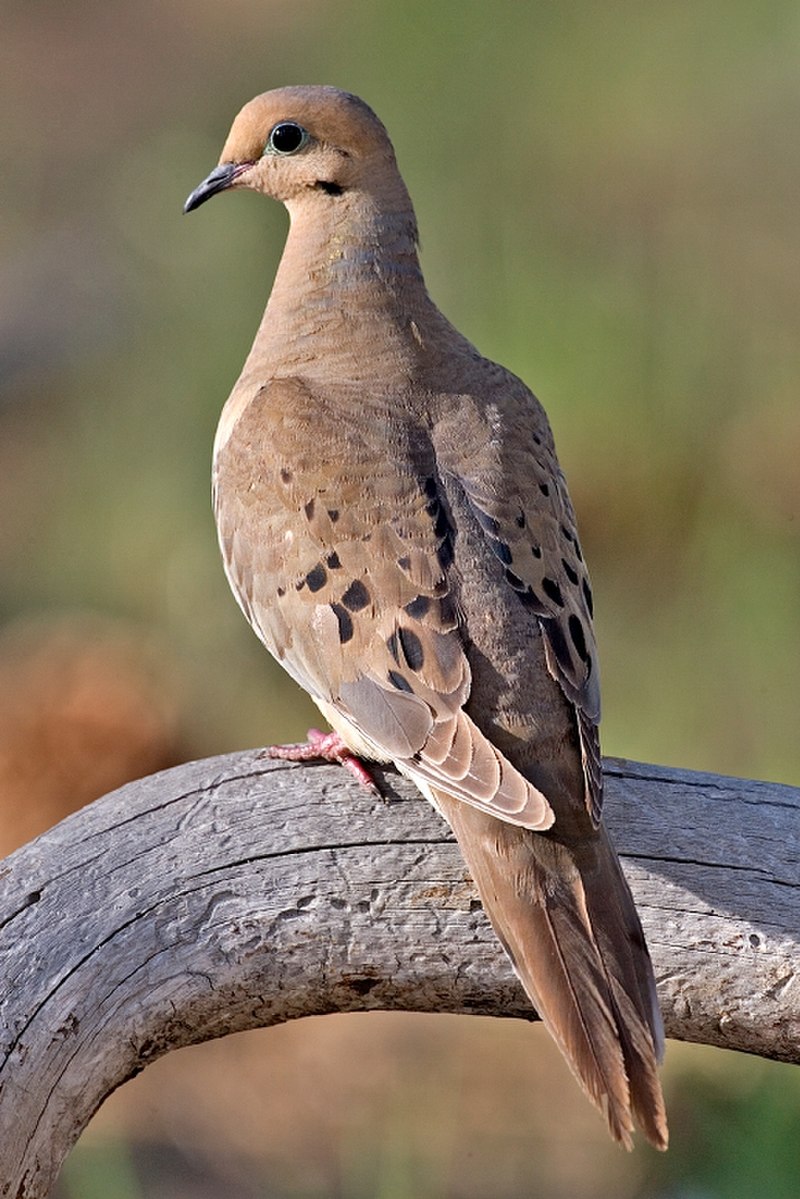
The Mourning Dove is a breathtakingly beautiful bird. It has stunning gray and brown feathers with white tipped wings, giving it an elegant appearance. Its long tail also adds to its graceful look in flight.
A symbol of peace and serenity, they are abundant across North America and can be found in gardens or open fields throughout the year.
As well as being popular game birds for hunters, they feed on grains such as wheat and millet providing important food sources for wildlife species including foxes, coyotes, skunks and raccoons.
These doves have a distinctive cooing sound that can often be heard echoing through woodlands during summer evenings making them one of nature’s greatest treasures.Scientific classification:
| Kingdom | Animalia |
| Phylum | Chordata |
| Class | Aves |
| Order | Columbiformes |
| Family | Columbidae |
| Genus | Zenaida |
| Species | Z. macroura |
Also Featured In: Most Common Nature Birds, Birds in Iowa Spring
8. Anna’s Hummingbird
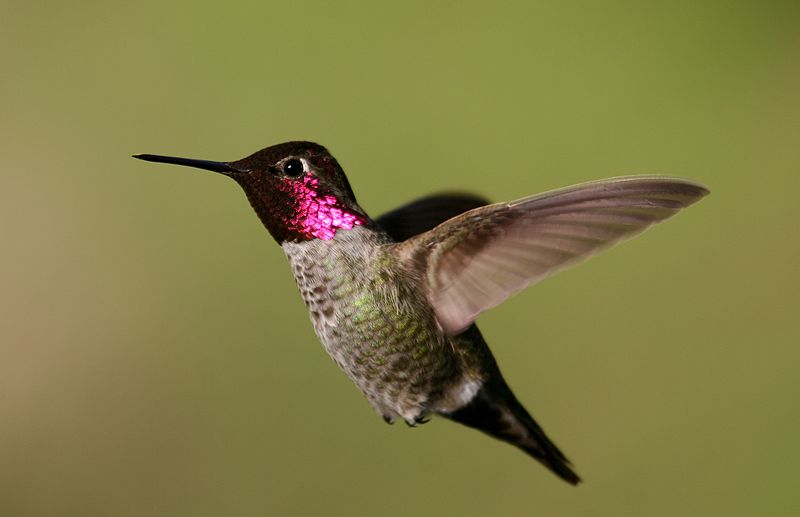
Anna’s hummingbird is a beautiful species of bird belonging to the Trochilidae family. Native to western coastal regions of North America, it was named after Anna Masséna, Duchess of Rivoli.
In the early 20th century, these birds bred only in northern Baja California and southern California but due to ornamental plant transplanting they can now be found across much of Pacific Coast region.
They are medium-sized with bright emerald green feathers on their back and crowns as well as rose-red patches at the throat for males which makes them quite distinguishable from other birds.
Their diet consists mainly nectar from flowers although they will occasionally feed on insects or spiders too making them important pollinators that help maintain healthy ecosystems.Scientific classification:
| Kingdom | Animalia |
| Phylum | Chordata |
| Class | Aves |
| Order | Apodiformes |
| Family | Trochilidae |
| Genus | Calypte |
| Species | C. anna |
Also Featured In: Orange County Birds You Need to See, Red birds You’ll See in Arizona
9. Allen’s Hummingbird
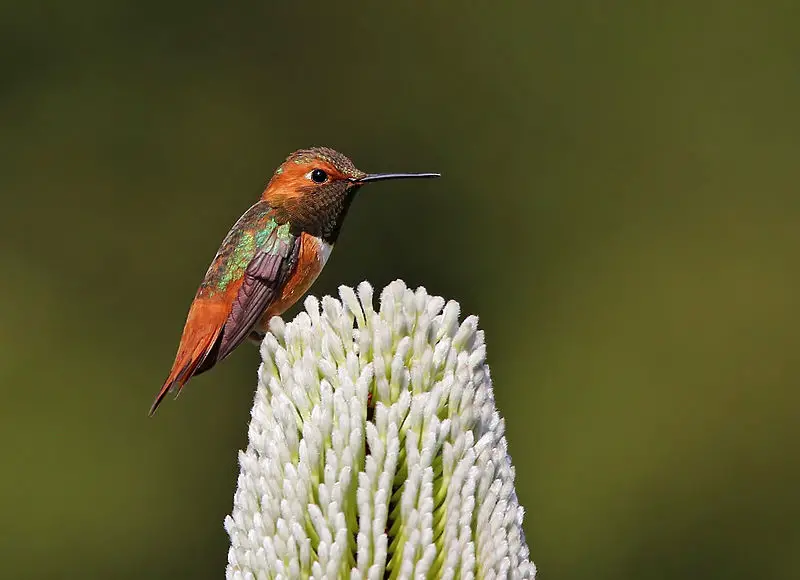
Allen’s Hummingbird is a beautiful species of hummingbird that breeds in the western United States. It stands only 3-3.5 inches long and its stunningly vibrant plumage make it an incredible sight to behold.
The male has a green back and forehead, with rust-colored (rufous) flanks, rump, and tail while his throat dazzles with an iridescent orange coloration.
Females are similarly colored but lack the colorful throat patch of males.
These birds feed primarily on nectar from flowers such as sagebrush, California fuchsia or currant bushes using their long bills and tongues to extract food from deep within them.
They also eat small insects for protein which they capture in flight like other hummingbirds do.
Allen’s Hummingbird can be found near chaparral shrubland during breeding season when wildflowers abound giving these tiny beauties plenty of sustenance.Scientific classification:
| Kingdom | Animalia |
| Phylum | Chordata |
| Class | Aves |
| Order | Apodiformes |
| Family | Trochilidae |
| Genus | Selasphorus |
| Species | S. sasin |
Also Featured In: Hummingbirds that Live in Ohio, Hummingbirds Live around Florida
10. California Gull
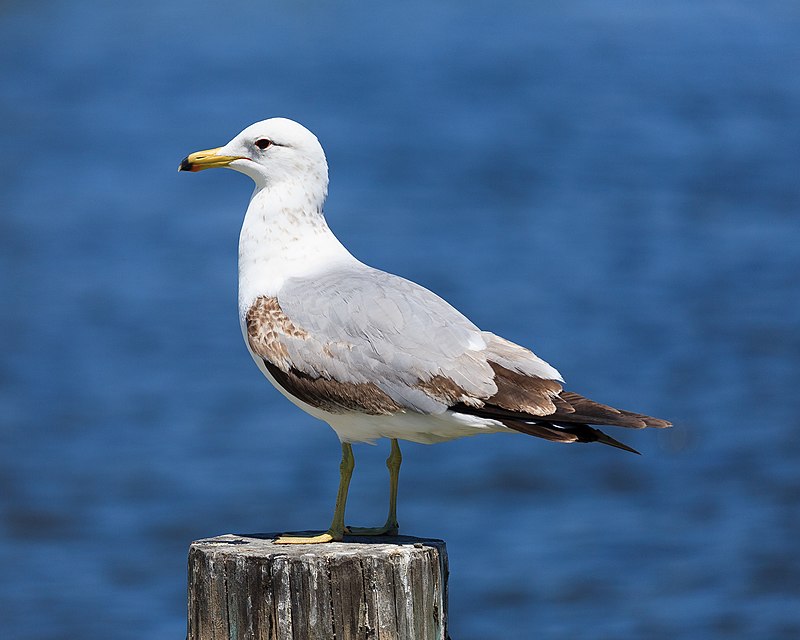
The California Gull is a medium-sized bird, smaller than the herring gull but larger than the ring-billed gull. It has a yellow bill with black ring and yellow legs.
Its head is rounder compared to other gulls and its body mainly white in color with grey back and wings.
They are mostly found around lakes, rivers or coasts of western North America where there is plenty of food available for them such as fish, insects and crustaceans which they consume on their daily diet.
During breeding season these birds form large colonies near water bodies or wetlands where they also make their nests using grasses sticks or feathers.
As omnivores they play an important role in maintaining balance within local ecosystems by eating both plants material like seeds & fruits as well as small mammals like rodents.Scientific classification:
| Kingdom | Animalia |
| Phylum | Chordata |
| Class | Aves |
| Order | Charadriiformes |
| Family | Laridae |
| Genus | Larus |
| Species | L. californicus |
Also Featured In: Yellowstone National Park Birds You Need To Know, Common Birds of Antelope Island State Park
11. Red-Winged Blackbird

The red-winged blackbird is a beautiful bird found in most of North America and Central America.
Its distinct features include a glossy black body, with white shoulder patches and bright red wing coverts year round.
It prefers wetland habitats such as marshes, ponds, lakeshores and agricultural fields. During breeding season they inhabit grassy areas near water then move south for the winter months.
For food they mainly eat insects but also consume wild fruit or grains.
They are very social birds often seen in large flocks during migration times when their unmistakable “conk-la-ree” call can be heard echoing across the sky.Scientific classification:
| Kingdom | Animalia |
| Phylum | Chordata |
| Class | Aves |
| Order | Passeriformes |
| Family | Icteridae |
| Genus | Agelaius |
| Species | A. phoeniceus |
Also Featured In: Flocks Birds around Us, Birds that Calls in the Morning
12. American Coot
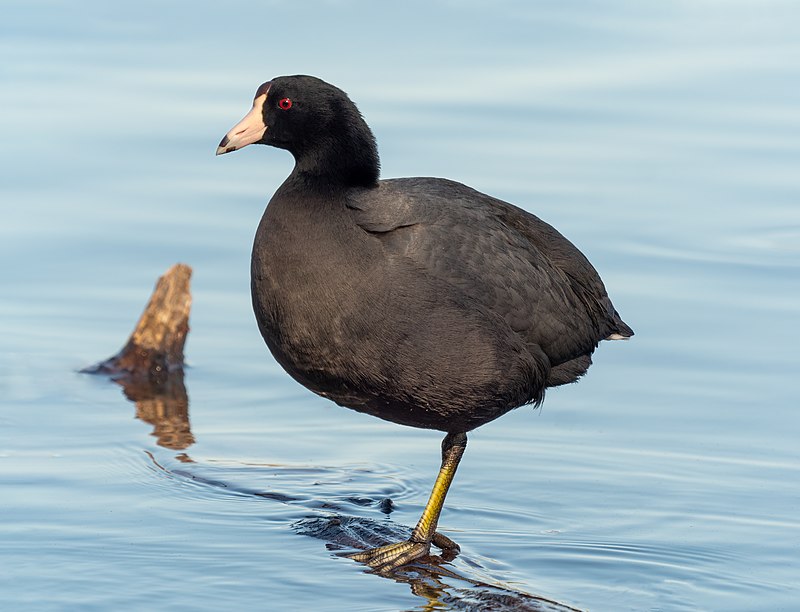
The American coot is a bird of the Rallidae family, commonly mistaken for ducks. However, they are only distantly related and have broad lobed scales on their lower legs and toes that fold back with each step to help them walk on dry land unlike ducks which have webbed feet.
Coots are omnivores who typically live in freshwater marshes, ponds and lakes but can also be found in brackish water habitats or even open oceans during migration season.
They feed mainly on algae and aquatic plants as well as small fish, snails, insects larvae and worms from time to time.
The males display territorial behaviour by chasing away intruders within their territory while females lay eggs mostly.
In floating nests made of vegetation near shorelines or islands among reeds where chicks hatch after about three weeks incubation period before swimming off into adulthood shortly afterwards at 10-12 weeks old.Scientific classification:
| Kingdom | Animalia |
| Phylum | Chordata |
| Class | Aves |
| Order | Gruiformes |
| Family | Rallidae |
| Genus | Fulica |
| Species | F. americana |
Also Featured In: Most Popular Bird Species in North America, Phoenix Birds You Should Know
13. Belted Kingfisher
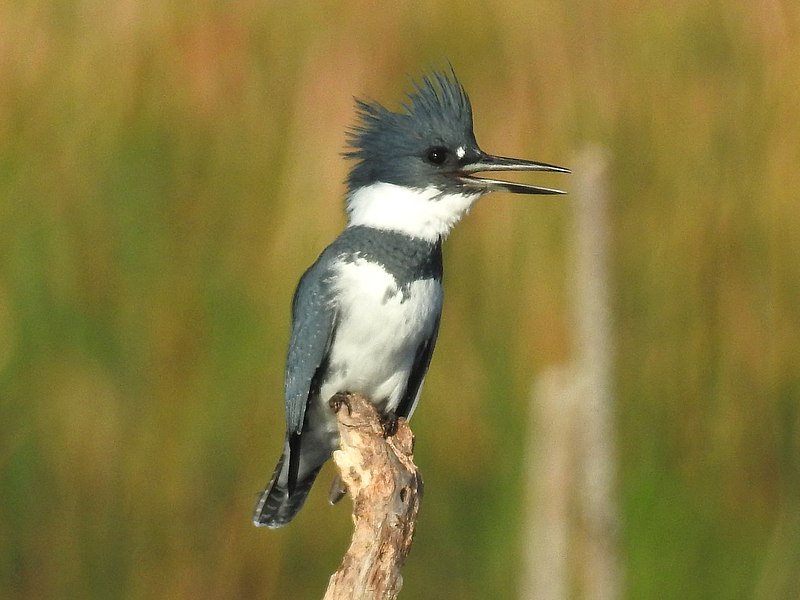
The belted kingfisher is a large, eye-catching bird native to North America. It belongs to the family Alcedinidae and has been divided into three subfamilies by recent research.
The species was first described in 1758 by Carl Linnaeus in his Systema Naturae.
This water Kingfisher stands out for its size as well as its striking plumage; males are bright blue on top with white below and females have rusty brown backs and wings with a thick black breast band across their chest.
They also possess an impressive call which can be heard from quite far away.
Belted kingfishers feed mainly on small fish but will sometimes also eat crustaceans, insects or even amphibians if they come across them while hunting around rivers or streams.
All in all, this is truly one remarkable bird that deserves our admiration.Scientific classification:
| Kingdom | Animalia |
| Phylum | Chordata |
| Class | Aves |
| Order | Coraciiformes |
| Family | Alcedinidae |
| Subfamily | Cerylinae |
| Genus | Megaceryle |
| Species | M. alcyon |
Also Featured In: Long Island Birds You Should Know, Birds that Live around Central Florida
14. Canada Goose
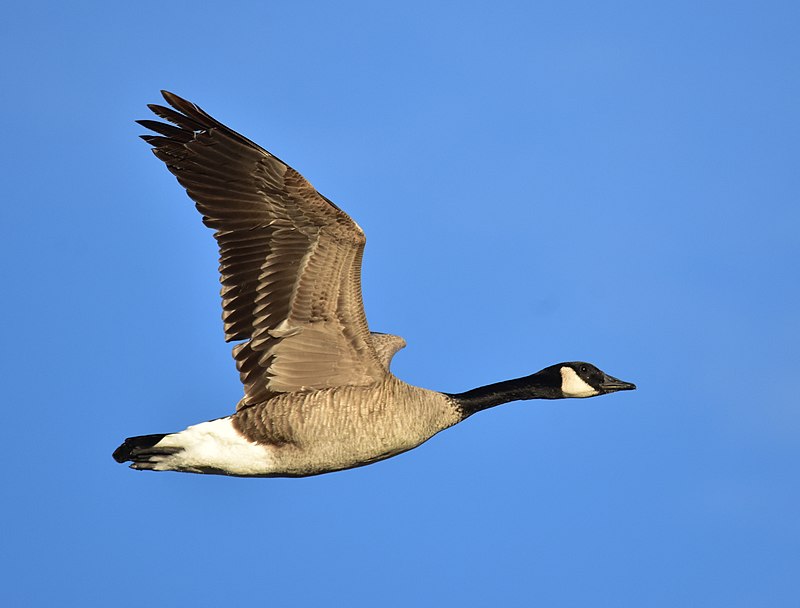
The Canada goose is a majestic bird with a black head and neck, white cheeks, chin and brown body. It’s native to North America but occasionally migrates to northern Europe across the Atlantic.
The species has been introduced in the United Kingdom, Ireland and Finland as well. Canada geese are strong flyers that travel in flocks for protection from predators; they also form monogamous pairs for life.
They feed on grasses or grains near ponds or wetlands where they make their nests of down which incubate eggs during summertime before hatching them out into goslings later on.Scientific classification:
| Kingdom | Animalia |
| Phylum | Chordata |
| Class | Aves |
| Order | Anseriformes |
| Family | Anatidae |
| Genus | Branta |
| Species | B. canadensis |
Also Featured In: Birds that Commonly Found in Pond , Common Birds in Saskatchewan
15. Great Horned Owl
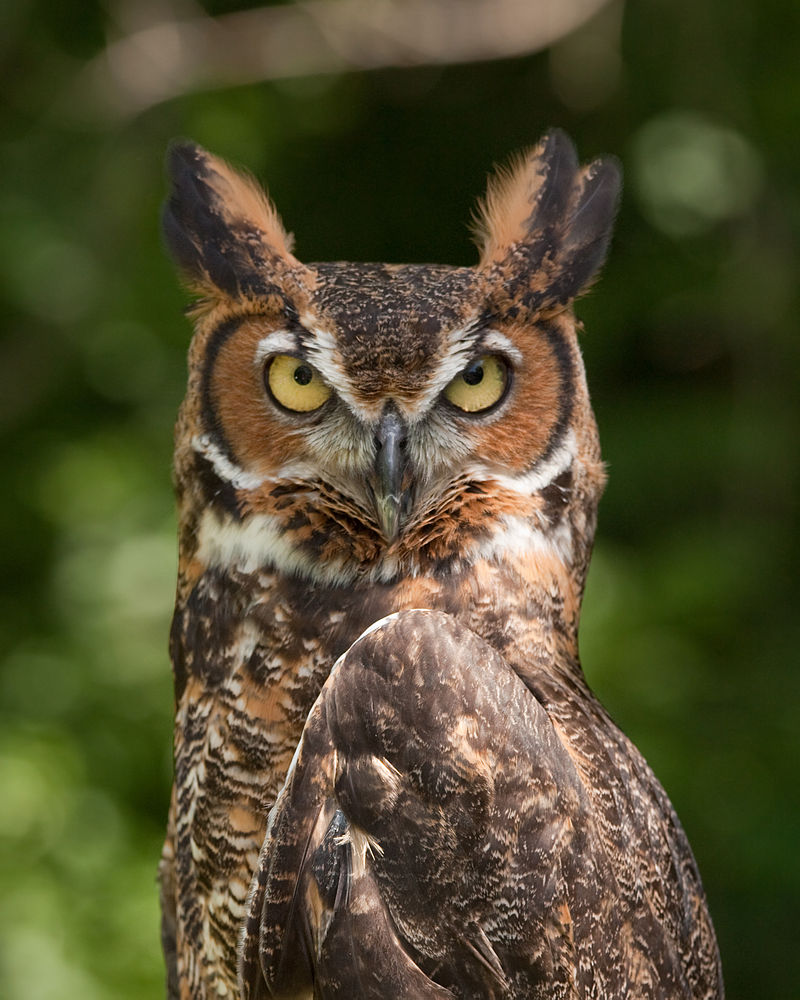
The Great Horned Owl is an impressive bird native to the Americas. It is well-known for its wide range and adaptability, as it can be found in many different habitats across the continent.
Its diet consists primarily of rabbits, hares, rats and mice; however, they are also known to consume skunks, geese and other birds too.
With their powerful talons capable of crushing prey with ease, these owls have earned themselves a fearsome reputation due to their incredible strength.
Their iconic horn-like tufts on either side of its head add another layer of intimidation which helps them stand out from other owls in the area.Scientific classification:
| Kingdom | Animalia |
| Phylum | Chordata |
| Class | Aves |
| Order | Strigiformes |
| Family | Strigidae |
| Genus | Bubo |
| Species | B. virginianus |
Also Featured In: Birds that Live in the Deserts, Birds You’ll Find in Zoo
16. Killdeer
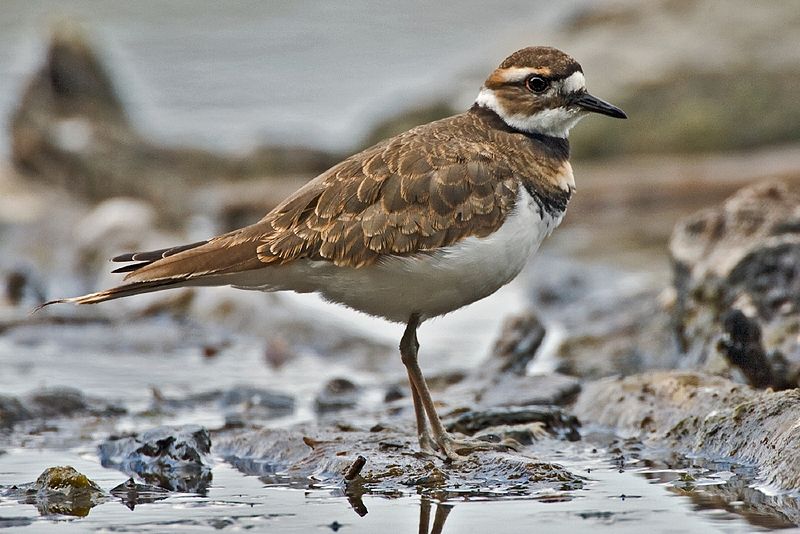
The Killdeer bird is a large plover found in the Americas. It has an unmistakable call which gives it its name, and boasts striking upperparts of brown with rufous fringes.
Its head features patches of white and black, while two distinctive bands adorn its neck – one black above, and one chestnut below.
The undersides are mostly white or pale buff-brown; their wings feature bright orange stripes when they take flight.
During breeding season males perform elaborate courtship rituals to attract females into establishing a pair bond; they also defend territories fiercely against other birds that encroach on them during this time.
In winter months some killdeers migrate southwards but many stay put throughout the cold weather too.
All in all these beautiful creatures provide us with quite a sight indeed.Scientific classification:
| Kingdom | Animalia |
| Phylum | Chordata |
| Class | Aves |
| Order | Charadriiformes |
| Family | Charadriidae |
| Genus | Charadrius |
| Species | C. vociferus |
Also Featured In: Wetlands Birds You Should Know, Common Birds of Houston
17. Lesser Goldfinch
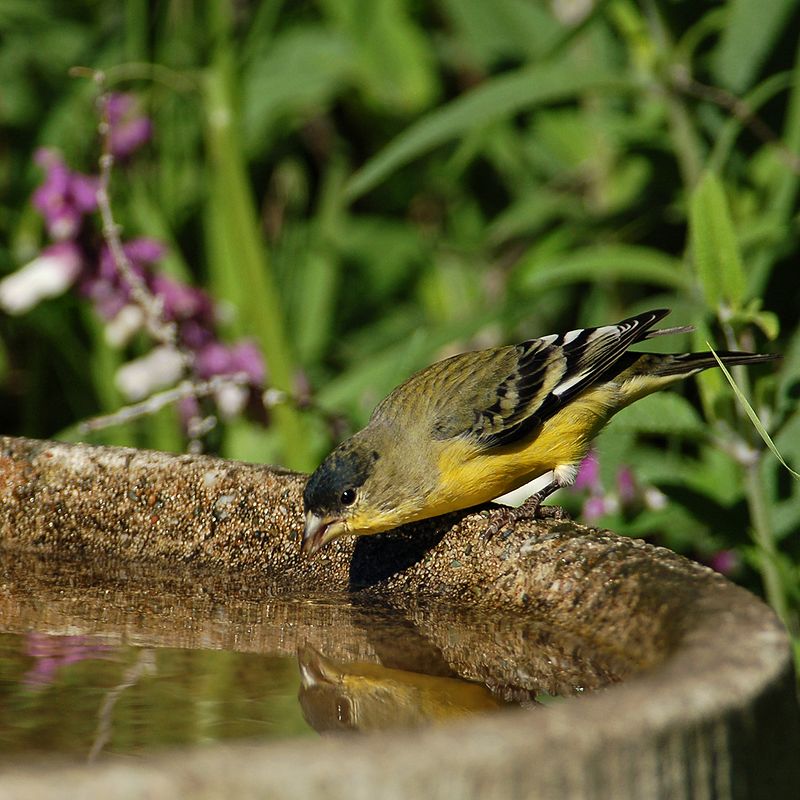
The Lesser Goldfinch is a tiny species of bird found in the Americas. It belongs to the same clade as American goldfinches and Lawrence’s goldfinches, which can be identified by their males having black or rarely green foreheads.
The face appears red or yellow on these birds unlike other species in its genus Spinus sensu stricto.
They are small songbirds with short bills, brown wings and tails with white edges, grey-brown backs and olive heads.
These birds inhabit open woodlands and fields where they feed mainly on seeds from weeds such as thistle, pigweed and ragweed but also consume insects at times during breeding season for additional nutrition.
In addition to being an important part of North America’s avian ecology, these birds have been popularized through recent artwork depicting them in various poses among flowers.Scientific classification:
| Kingdom | Animalia |
| Phylum | Chordata |
| Class | Aves |
| Order | Passeriformes |
| Family | Fringillidae |
| Subfamily | Carduelinae |
| Genus | Spinus |
| Species | S. psaltria |
Also Featured In: Top Birds Found in Mexico, Central Texas Birds
18. Turkey Vulture
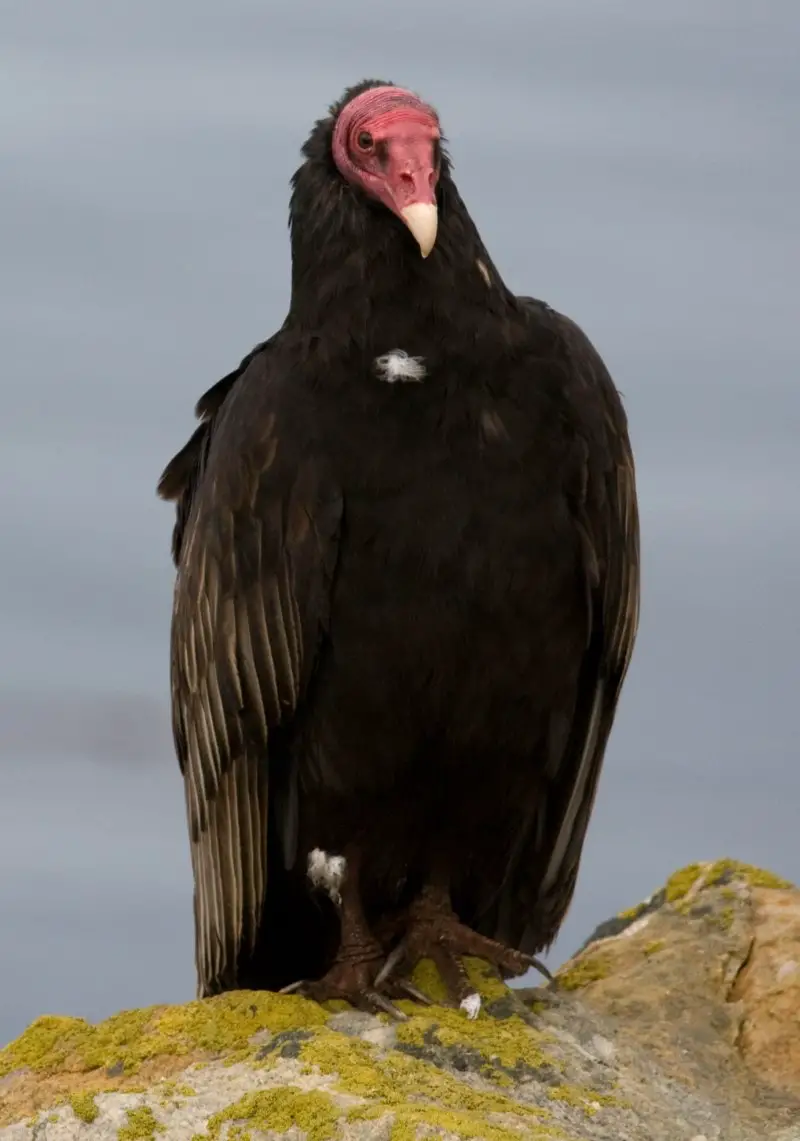
The turkey vulture is a large bird of prey that can be found in many parts of the world. It has a wingspan of up to 6 feet and its feathers are mostly black with brownish-red patches on the underside which give it an overall dark red appearance.
Its head is bald, which helps protect it from getting overheated when flying long distances looking for food.
The Turkey Vulture usually feeds off carrion but will also feed on fruit and insects.
Its keen eyesight allows them to spot potential meals from miles away while they soar through the sky using their broad wings and thermal air currents to stay aloft without expending much energy.
They are very important scavengers as they keep ecosystems healthy by consuming dead animals before disease can spread amongst living creatures or contaminate local water sources like rivers or lakesScientific classification:
| Kingdom | Animalia |
| Phylum | Chordata |
| Class | Aves |
| Order | Accipitriformes |
| Family | Cathartidae |
| Genus | Cathartes |
| Species | C. aura |
Also Featured In: Turkey Birds You Should Know, Scavengers Birds You Should Know
19. Marbled Godwit
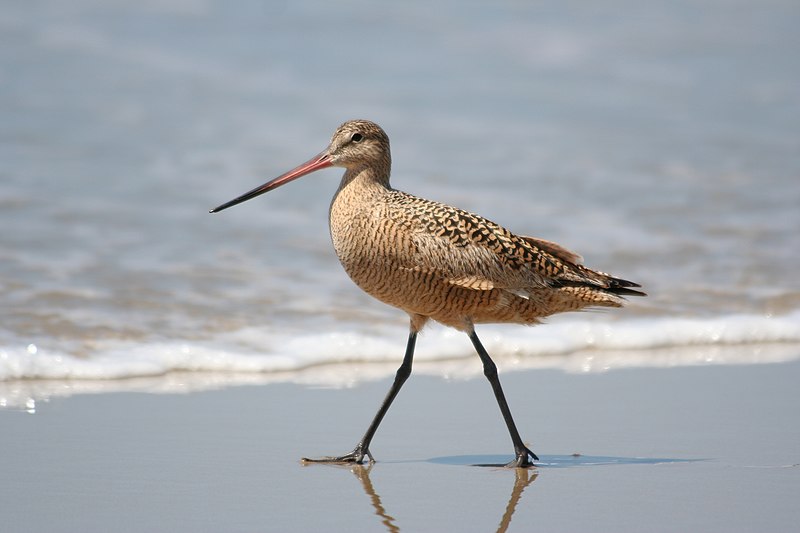
The Marbled Godwit is a large migratory shorebird in the Scolopacidae family and is one of the largest species amongst four godwits.
It was first described by English naturalist George Edwards in 1750, as ‘The Greater American Godwit’.
The bird has long legs and bill for probing mudflats for food. Their plumage varies from mottled gray to reddish or brown on their upperparts, with white underparts that contrast against it.
During breeding season they can be seen along northern prairies in North America and migrate south towards Mexico during winter months.
They are omnivorous feeders but prefer aquatic insects like crustaceans, larvae etc., which makes them an important element of wetland ecosystems across its range.Scientific classification:
| Kingdom | Animalia |
| Phylum | Chordata |
| Class | Aves |
| Order | Charadriiformes |
| Family | Scolopacidae |
| Genus | Limosa |
| Species | L. fedoa |
Also Featured In: Birds That Live In Humboldt Bay, Newport Bay Birds You Need To Know
20. Great Egret

The Great Egret is a large, white bird found in many regions of the world. It has four subspecies that reside across Asia, Africa, Americas and southern Europe.
This species usually lives near bodies of water such as lakes and marshes. They are also now starting to spread into more northern areas of Europe due to climate change.
These birds have long yellow legs with an impressive wingspan for their size which allows them to soar majestically through the sky hunting for fish or amphibians in shallow waters below.
Their feathers have been used historically by Native Americans as part of traditional garments or ceremonies but this practice should be avoided today so these amazing creatures can thrive without harm from humans.Scientific classification:
| Kingdom | Animalia |
| Phylum | Chordata |
| Class | Aves |
| Order | Pelecaniformes |
| Family | Ardeidae |
| Genus | Ardea |
| Species | A. alba |
Also Featured In: Most common Birds in France, Most Common Romanian Birds
21. Common Raven
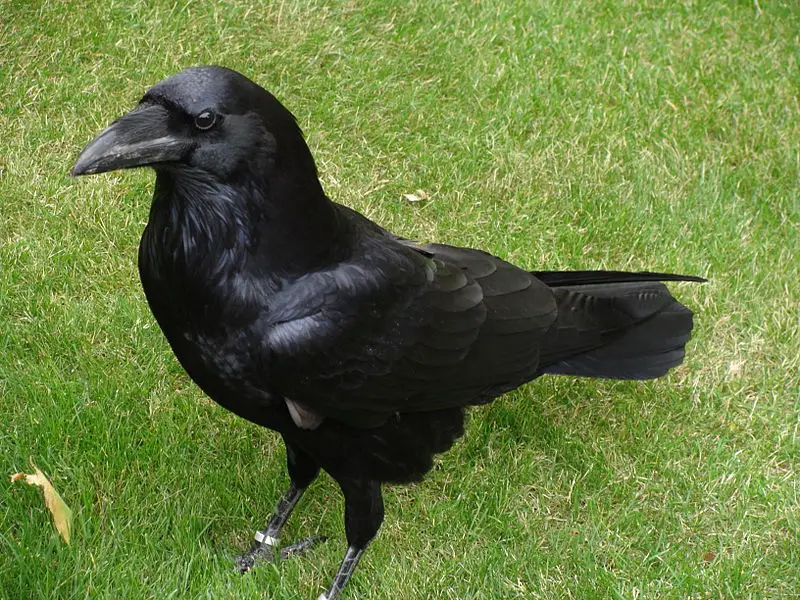
The Common Raven is an iconic black bird found throughout the Northern Hemisphere. It belongs to the Corvus corax species of passerines, and has at least eight subspecies with little physical variation between them.
Recent research however suggests there are significant genetic differences among populations from various areas.
They have a large wingspan of up to 1m and their call can be heard over great distances due to its deep croaking sound; they also use mimicry for communication purposes like many other birds do.
The ravens diet consists mostly of carrion, insects and fruits but they will scavenge in human settlements as well when food sources become scarce.
Their nests require plenty of space so these birds prefer open habitats such as tundra or mountain regions- ideal conditions for their long distance migrations.Scientific classification:
| Kingdom | Animalia |
| Phylum | Chordata |
| Class | Aves |
| Order | Passeriformes |
| Family | Corvidae |
| Genus | Corvus |
| Species | C. corax |
Also Featured In: Birds of Poland, Birds of Symbolism
22. Great Blue Heron

The Great Blue Heron is a majestic wading bird found in many parts of North America, Central America, the Caribbean and even as far away as the Galapagos Islands.
It has an impressive wingspan which can reach up to six feet wide. Its feathers are mainly bluish-gray with brownish streaks on both its neck and chest while its head displays white plumes.
The adult herons can also be identified by their yellow bill and legs.
They live near bodies of water such as lakes, marshes or rivers where they feed on fish using a spear like motion with their sharp bills.
An all-white population exists only in south Florida and the Florida Keys making it quite unique.Scientific classification:
| Kingdom | Animalia |
| Phylum | Chordata |
| Class | Aves |
| Order | Pelecaniformes |
| Family | Ardeidae |
| Genus | Ardea |
| Species | A. herodias |
Also Featured In: Common Birds in Canada, Everglades Birds
23. Song Sparrow

The Song Sparrow (Melospiza melodia) is a small, yet abundant bird found in North America.
They have brown upperparts with dark streaks and are white underneath, complete with a distinct dark brown spot on the breast.
Their cap is also brown and long roughed feathers can be seen sprouting from their neck area.
This sparrow species is highly variable and adaptable to many different environments including dry brush land, wetlands or open fields.
It has been noted that adult song sparrows will sing even during winter months when other birds remain quiet.
These energetic little animals make for great backyard companions as they flit about singing their lovely melodies.Scientific classification:
| Kingdom | Animalia |
| Phylum | Chordata |
| Class | Aves |
| Order | Passeriformes |
| Family | Passerellidae |
| Genus | Melospiza |
| Species | M. melodia |
Also Featured In: Birds that Live in Vancouver, Birds of Nova Scotia
24. Red-Tailed Hawk
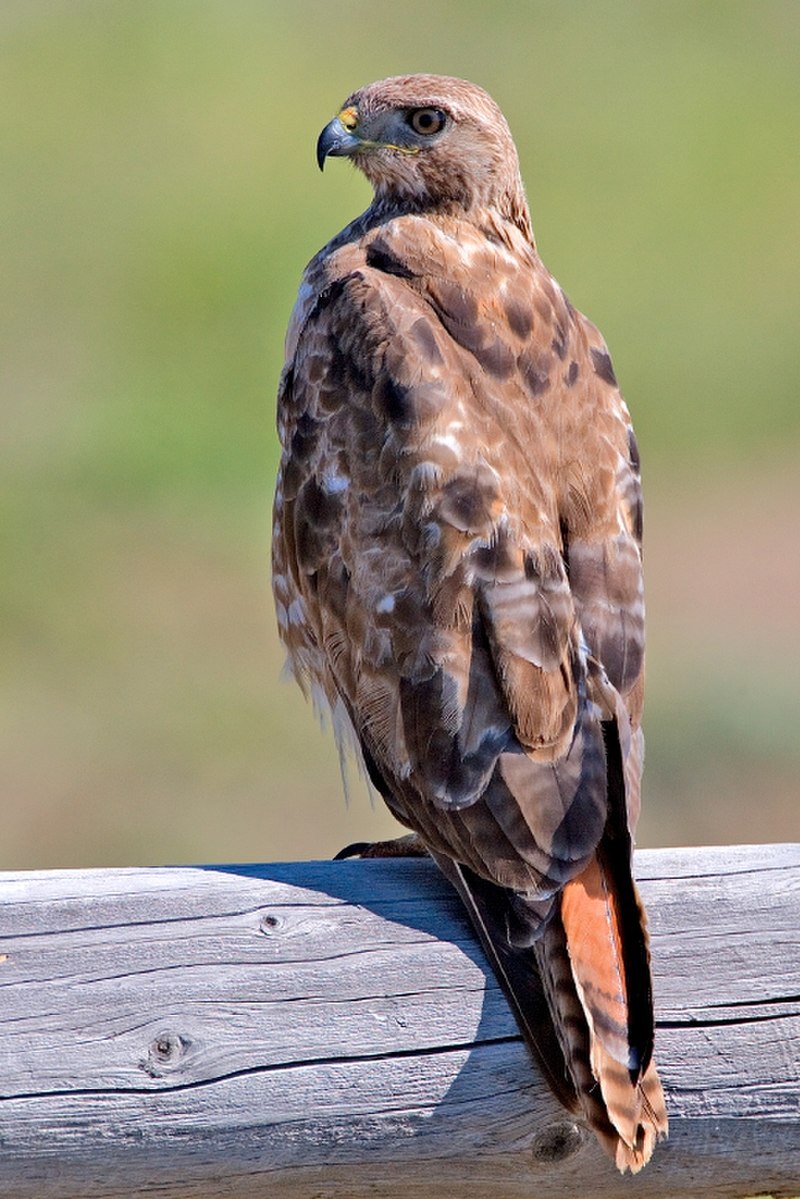
The Red-tailed Hawk is a majestic bird of prey with its distinctive red tail. It can be found throughout North America, from Alaska in the north to Panama and the West Indies in the south.
This species belongs to Buteo genus, which makes it one of most common raptors on earth.
These hawks mainly hunt small mammals such as rabbits or squirrels but also feed on reptiles and birds during migration season.
Unlike other predator birds, they prefer open areas for hunting like fields or grasslands rather than dense forests.
They build their nests high up on trees where they stay all year long unless disturbed by humans or animals nearby.
Their presence has become an iconic part of American culture due to their frequent sightings around homes and parks alike making them beloved creatures among people everywhere.Scientific classification:
| Kingdom | Animalia |
| Phylum | Chordata |
| Class | Aves |
| Order | Accipitriformes |
| Family | Accipitridae |
| Genus | Buteo |
| Species | B. jamaicensis |
Also Featured In: Dominican Republic birds, Small Kentucky Birds
25. Black-Crowned Night Heron
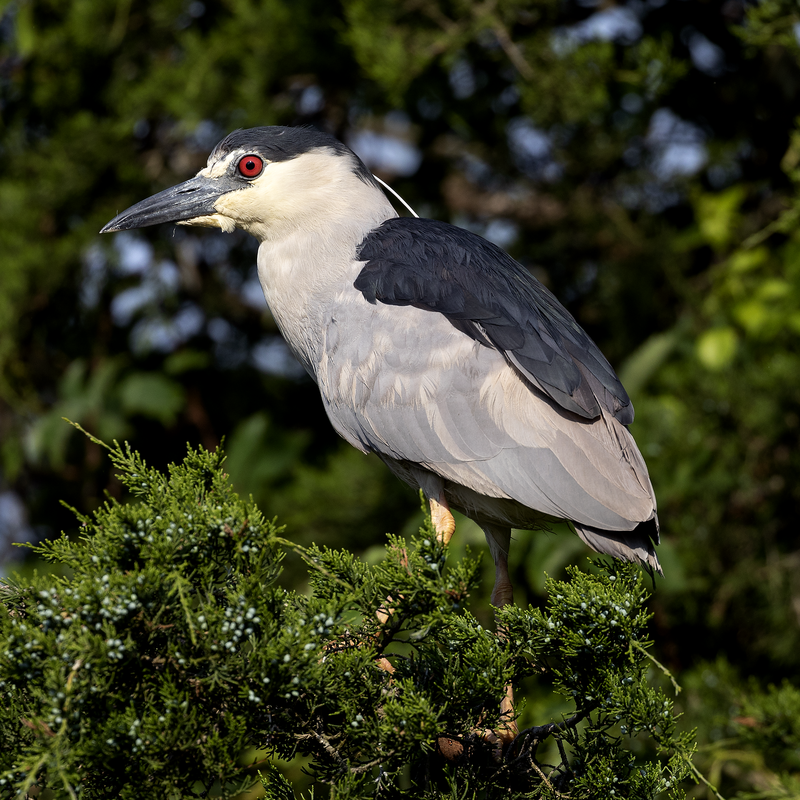
The Black-crowned night heron (Nycticorax nycticorax) is a medium-sized bird found in various parts of the world, including Europe, Asia and North and South America.
It has black crowns on its head with white feathers underneath. Its wings are greyish brown while its underparts are mostly white.
This species can be seen foraging near shallow water or along coastlines during dusk or dawn as it hunts small fish, amphibians and crustaceans.
They also feed on insects such as grasshoppers and beetles which they find in meadows close to freshwater bodies like lakes or ponds where they breed during springtime making nests using twigs lined with reeds and leaves near these waterside habitats.
In Australasia, this species hybridizes with the nankeen night heron that inhabits those areas instead; however both populations remain distinct from each other despite their overlap range regions.Scientific classification:
| Kingdom | Animalia |
| Phylum | Chordata |
| Class | Aves |
| Order | Pelecaniformes |
| Family | Ardeidae |
| Genus | Nycticorax |
| Species | N. nycticorax |
Also Featured In: Common Birds Found in Switzerland, Birds of Kauai, Hawaii
26. Eurasian Whimbrel
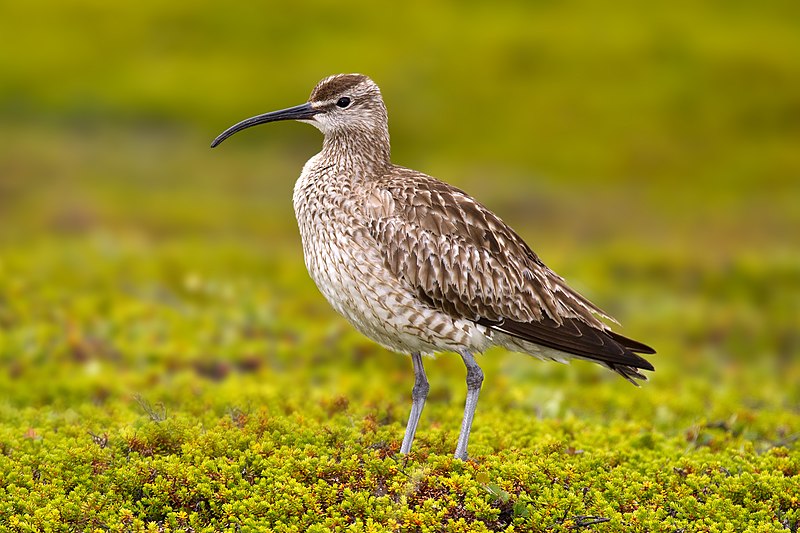
Eurasian Whimbrels are a species of wading bird commonly found in subarctic regions of Europe and Asia.
They have white rumps, long curved bills, brown wings and backs with light streaking on the lower breast.
These birds feed mainly on crustaceans, mollusks or worms they find while probing in the mud during low tide.
During breeding season they can be seen nesting near coastal areas or wetlands where food is plentiful.
This species has recently been split from Hudsonian whimbrels but some authorities still consider them to be one species due to their similarities which includes migration patterns as well as habitat preferences.
Eurasian whimbrels are an important part of many ecosystems because they help control insect populations by eating larvae before it can cause damage to crops or vegetation nearby.Scientific classification:
| Kingdom | Animalia |
| Phylum | Chordata |
| Class | Aves |
| Order | Charadriiformes |
| Family | Scolopacidae |
| Genus | Numenius |
| Species | N. phaeopus |
Also Featured In: Singapore Birds, Shetland Islands Birds You Should Know
27. Snowy Egret
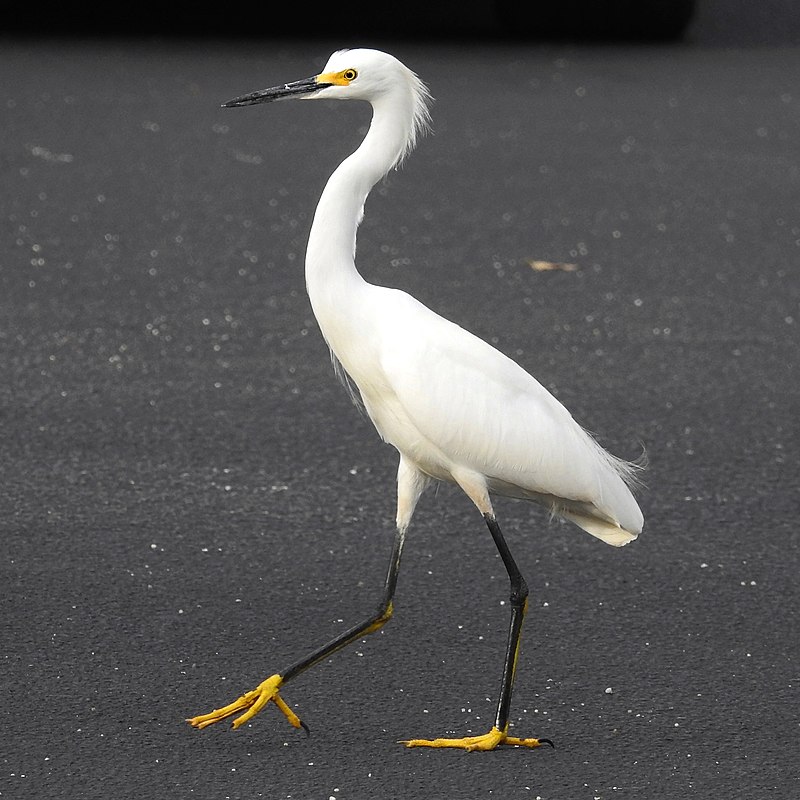
The Snowy Egret is a small white heron native to North America. Its scientific name, Egretta thula, comes from Provençal French for the little egret and an incorrect reference to the Black-necked Swan by Chilean naturalist Juan Ignacio Molina in 1782.
This beautiful bird has black legs with yellow feet, and a long plume of feathers on its head that often appears as if it’s wearing a crown.
It feeds primarily on insects and aquatic life like fish or frogs making it well adapted for both wetland habitats such as marshes or swamps plus coastal areas close to shorelines.
With their graceful movements they are truly delightful creatures to observe while out exploring nature.Scientific classification:
| Kingdom | Animalia |
| Phylum | Chordata |
| Class | Aves |
| Order | Pelecaniformes |
| Family | Ardeidae |
| Genus | Egretta |
| Species | E. thula |
Also Featured In: Trinidad and Tobago birds, Swamps Birds You Should Know
28. Least Tern
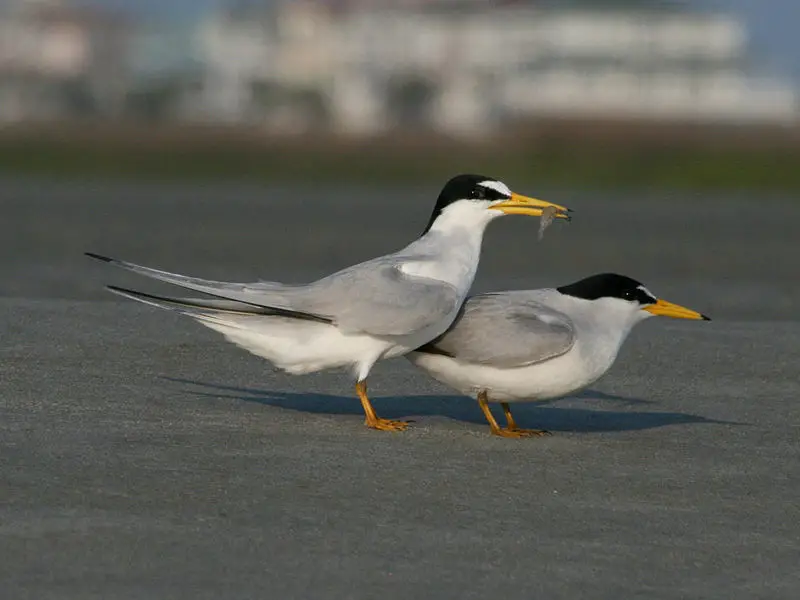
The Least Tern is a species of tern native to North America and northern South America. It has many close relatives, such as the yellow-billed tern and Peruvian tern from South America, or the little tern from the Old World.
The bird measures 8.7 – 9.4 inches in length with a wingspan of 16–18 inches acrosss, making it an intermediate size between most other species of birds within its family groupings.
Its feathers are usually gray on top with white underneath and typically have darker accents near their heads along with bright red bills for feeding during summer months when they mate upon beaches found throughout these regions mentioned above.
They feed mainly on small fish that live at shallow depths near shorelines where they also nest nearby due to migratory patterns which take place annually each year.
Hence why this particular bird does not travel far distances away from areas known as home for them over long periods of time like some other types do.Scientific classification:
| Kingdom | Animalia |
| Phylum | Chordata |
| Class | Aves |
| Order | Charadriiformes |
| Family | Laridae |
| Genus | Sternula |
| Species | S. antillarum |
Also Featured In: Aruba birds, Most Common Birds in South America Birds
29. Chestnut-Backed Chickadee
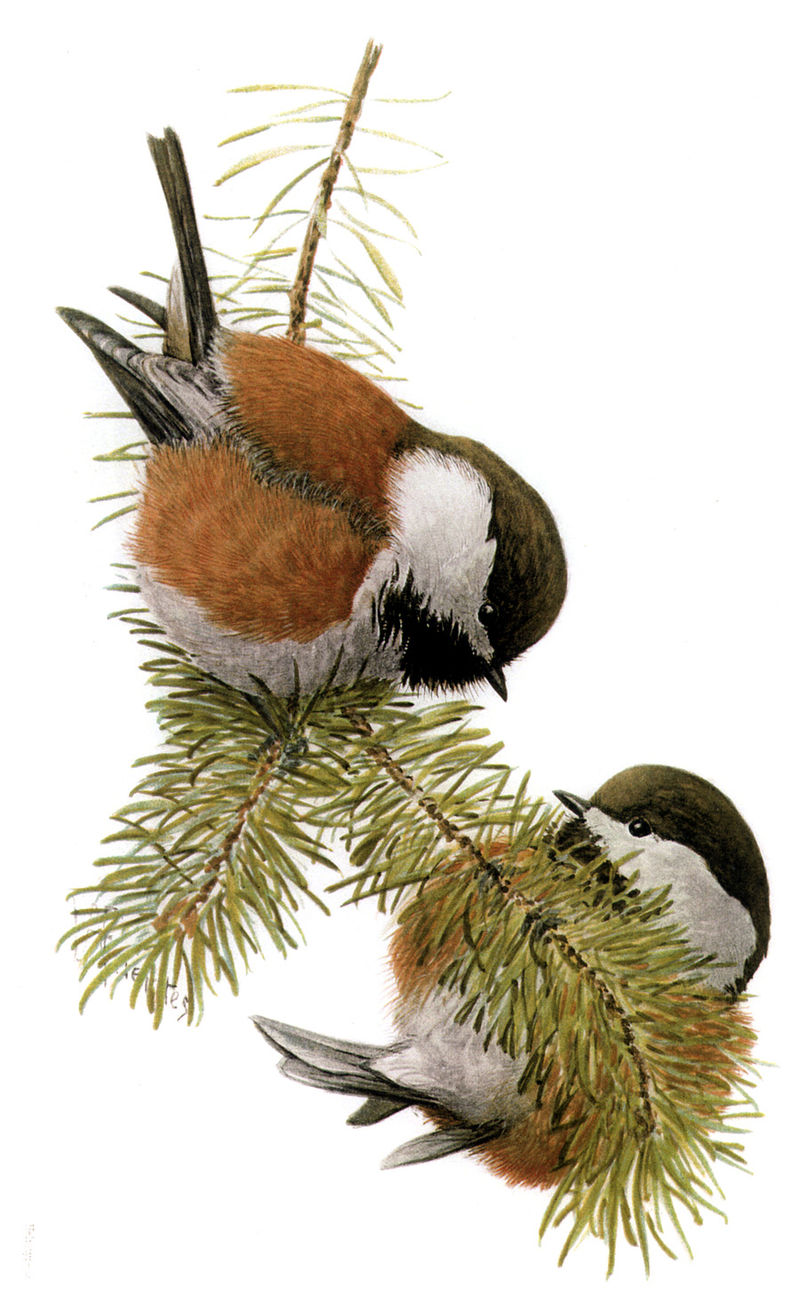
The Chestnut-backed Chickadee is a small passerine bird in the tit family, Paridae. It lives within the Pacific Northwest region of America and Canada; its range extending from southern Alaska to southwestern California.
This species remains a permanent resident throughout its area rather than migrating seasonally, although feeding flocks may temporarily move short distances for food sources.
They are commonly found in woodlands with dense understory vegetation as well as suburban gardens.
The male and female birds can be distinguished by their distinctive patterned plumage: males have brown backs while females are grayer above but both share white bellies and buffy sides striped with black barring across their wings and tails.
These sociable birds usually feed on insects or seeds which they obtain from trees or shrubs using their sharp beaks.Scientific classification:
| Kingdom | Animalia |
| Phylum | Chordata |
| Class | Aves |
| Order | Passeriformes |
| Family | Paridae |
| Genus | Poecile |
| Species | P. rufescens |
Also Featured In: Chickadees Birds, Common Southern Californian Birds
30. Oak Titmouse
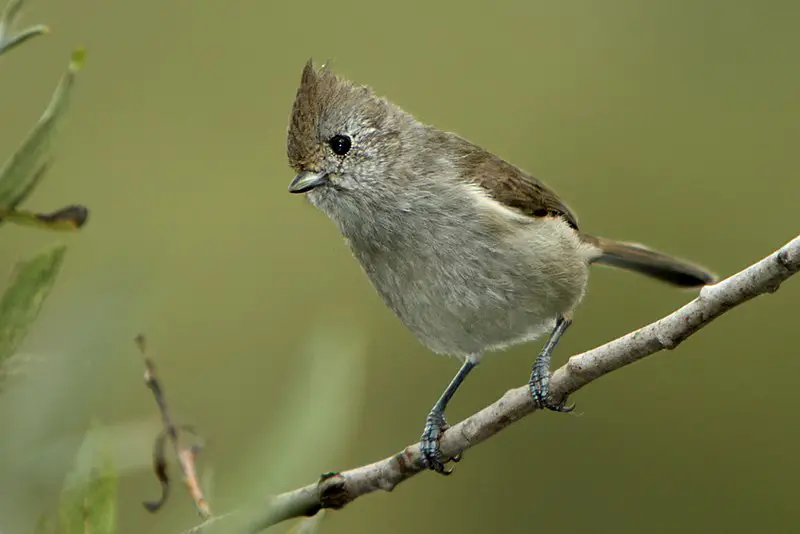
The Oak Titmouse is a small passerine bird of the tit family, Paridae. It has an overall grayish-brown plumage with a cream-colored undersides and its face is plain in coloration lacking any distinct patterning or markings.
The distinguishing feature of this species however, is the tufted crest on top of its head that gives it a unique appearance.
They are native to western North America where they inhabit oak woodlands and chaparral habitats at elevations between sea level up to 5500 feet above sea level.
These birds feed mostly on insects such as caterpillars but also consume seeds and fruits during colder months when insect prey becomes scarce.
In addition, they have been seen stealing food from other birds’ nests including acorn Woodpecker’s caches.Scientific classification:
| Kingdom | Animalia |
| Phylum | Chordata |
| Class | Aves |
| Order | Passeriformes |
| Family | Paridae |
| Genus | Baeolophus |
| Species | B. inornatus |
Also Featured In: Marin Birds You Should Know,
31. American Bushtit
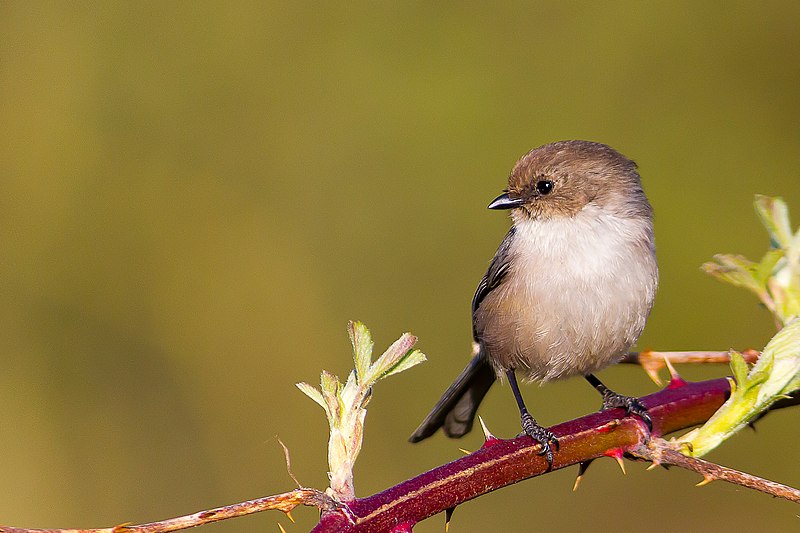
The American bushtit is a small, social bird found in the New World. It’s the only species of its genus and family, Psaltriparus minimus.
First described by John Kirk Townsend in 1837, it inhabits forests and coasts from Alaska to Mexico.
With their tiny size (4-5 inches) they are easily identified by their gray or brown backs with white underparts.
Bushtits have long wings allowing them to travel quickly between trees; they form flocks that move together through branches looking for food such as insects, spiders eggs and fruit while emitting soft chirps or squeaks.
They build beautiful large pendulous nests made of mosses which hang from tree branches high above ground level where they sleep at night.
These charming birds make delightful company during outdoor activities like hiking or camping trips.Scientific classification:
| Kingdom | Animalia |
| Phylum | Chordata |
| Class | Aves |
| Order | Passeriformes |
| Family | Aegithalidae |
| Genus | Psaltriparus Bonaparte, 1850 |
| Species | P. minimus |
Also Featured In: Birds That Live in Colorado, Birds Live Near San Diego
32. Marbled Murrelet
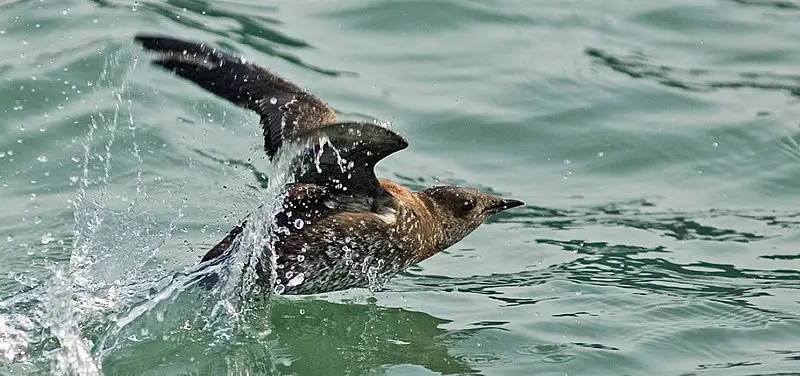
The marbled murrelet is a small seabird from the North Pacific that belongs to the auk family. It can be found nesting in old-growth forests at higher latitudes where trees cannot grow, or on the ground.
This habit of nesting was only discovered after an astute tree climber spotted a chick back in 1974 – making it one of the last birds species native to North America whose nest remained unknown until then.
With its distinctive black and white plumage, this bird stands out amongst others; yet despite being so unique, their population has been declining due to human activity over recent years.
We must act now if we are to protect these fascinating creatures for future generations.Scientific classification:
| Kingdom | Animalia |
| Phylum | Chordata |
| Class | Aves |
| Order | Charadriiformes |
| Family | Alcidae |
| Genus | Brachyramphus |
| Species | B. marmoratus |
Also Featured In: Auks Species, Birds You’ll Find in Vancouver Island
33. Black Phoebe
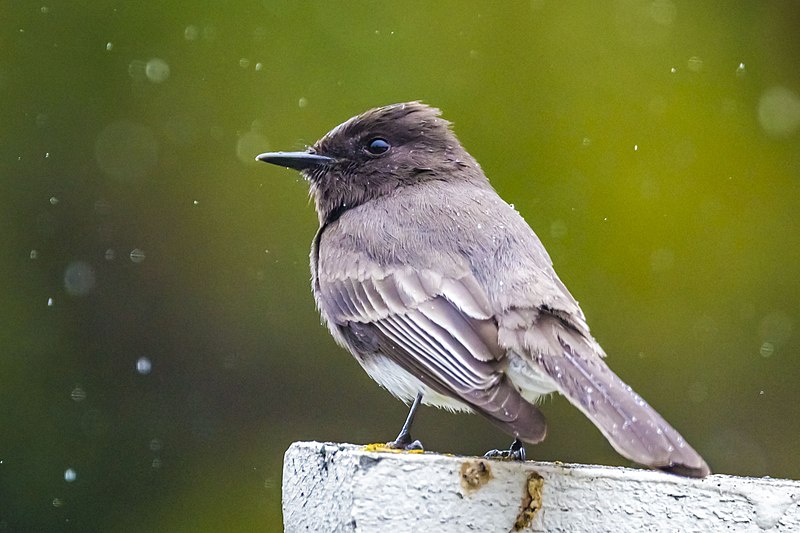
The black phoebe is a beautiful passerine bird belonging to the tyrant-flycatcher family. It breeds from southwest Oregon and California south through Central and South America, where it can be found year-round.
However, its northern populations tend to migrate seasonally in some areas. Six subspecies of this species have been identified so far: two are occasional visitors while the others are more common residents in their range.
The adult has mainly dark grey upperparts with a white belly; juveniles may show brownish tones instead of grey ones on their back.
Its main diet consists of insects which it catches by hovering over water or flying out after them from perches near rivers or streams – hence why they’re often seen around these places.Scientific classification:
| Kingdom | Animalia |
| Phylum | Chordata |
| Class | Aves |
| Order | Passeriformes |
| Family | Tyrannidae |
| Genus | Sayornis |
| Species | S. nigricans |
Also Featured In: Flycatchers Species, Birds Commonly Found in Northern California
34. Ring-Billed Gull
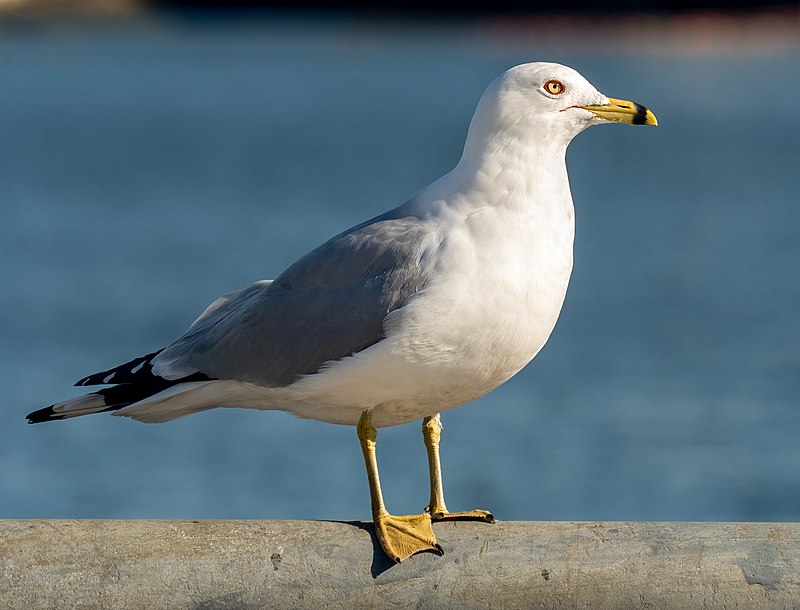
The Ring-billed Gull is a medium sized seabird that can be seen throughout North America. Its head, neck and underparts are white while its back and wings are silver gray in color.
It has a relatively short yellow bill with a dark ring around it, as well as yellow legs.
The genus name for this species of gull comes from the Latin word ‘Larus’ which referred to large sea birds or gulls; while the specific delawarensis refers to the Delaware River where these birds were first discovered.
These beautiful creatures thrive near coasts, lakeshores and other bodies of water but also have been known to inhabit urban areas such as parks close by those watersides due to their adaptability towards human habitats.Scientific classification:
| Kingdom | Animalia |
| Phylum | Chordata |
| Class | Aves |
| Order | Charadriiformes |
| Family | Laridae |
| Genus | Larus |
| Species | L. delawarensis |
Also Featured In: Gulls Species, Most Common Lake Birds
35. Western Gull
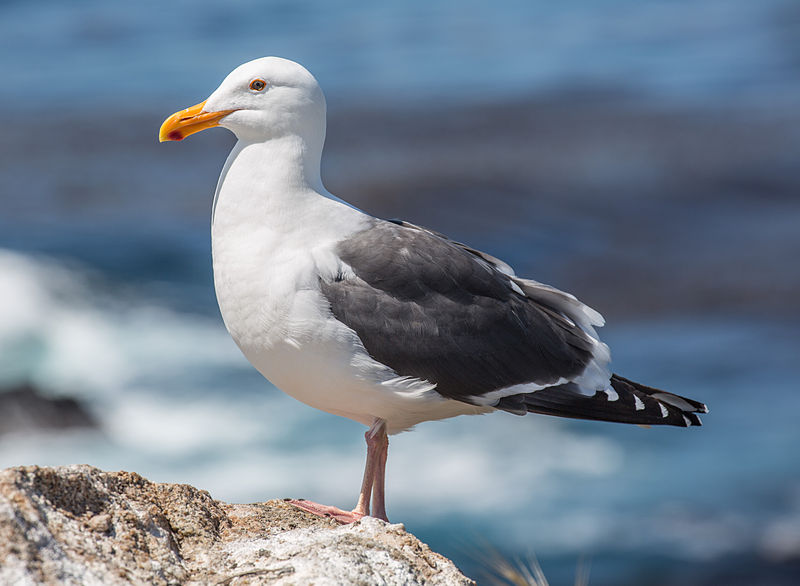
The Western Gull is a majestic seabird found on the West Coast of North America, ranging from British Columbia to Baja California. It has a large white head and stands between 22-27 inches in size.
Its upper parts are gray while its underparts range from brownish grey to white depending on age or sex of the bird.
The most distinguishing feature is its yellow feet which set it apart from other gulls in the area such as Larus livens.
These birds feed by scavenging for food including fish, mollusks, crustaceans and even carrion when available.
They also nest near ocean shores with their eggs hatching anywhere within 28 days after being laid. A beautiful sight to behold at any beach; these birds will surely captivate you with their grandeur.Scientific classification:
| Kingdom | Animalia |
| Phylum | Chordata |
| Class | Aves |
| Order | Charadriiformes |
| Family | Laridae |
| Genus | Larus |
| Species | L. occidentalis |
Also Featured In: Birds that Live in the Ocean , Birds of Oregon Coast
36. Double-Crested Cormorant

The double-crested cormorant is a majestic bird with an impressive wingspan, found across North America from the Aleutian Islands all the way down to Mexico.
Its black plumage stands out against its bright orange-yellow facial skin and some extended patches of white feathers on each side of its throat.
It measures between 28 – 35 inches in length and has webbed feet that enable it to swim gracefully through rivers and lakes, as well as coastal areas.
These birds are known for their voracious appetite for fish, sometimes diving over 100 ft deep into water looking for food.
Despite this reputation they also feed on crustaceans, amphibians and insects when available.
Cormorants have been part of many cultures throughout history due to their remarkable ability to fly long distances making them valued messengers or companions during fishing expeditions at sea.Scientific classification:
| Kingdom | Animalia |
| Phylum | Chordata |
| Class | Aves |
| Order | Suliformes |
| Family | Phalacrocoracidae |
| Genus | Nannopterum |
| Species | N. auritum |
Also Featured In: Cormorant Species, Water Birds Live around Us
37. Brandt’s Cormorant
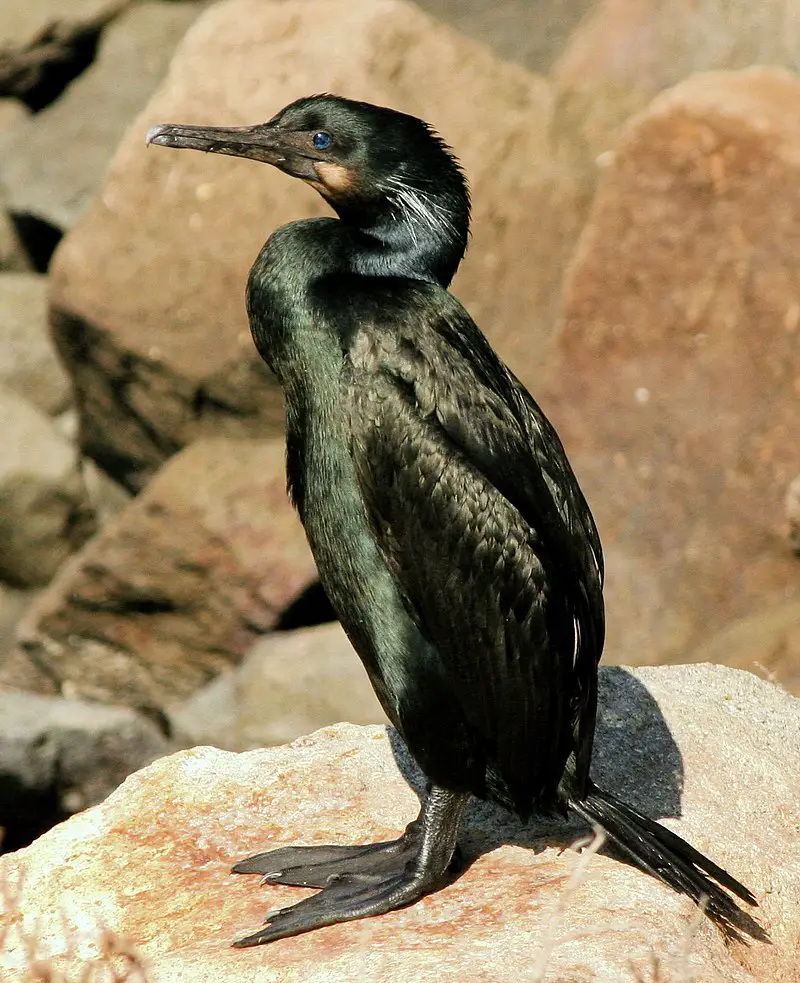
Brandt’s cormorant is a seabird of the Cormorant family that inhabits the Pacific coast of North America.
In summer, it can be found from Alaska to Gulf of California but its population northwards migrate south during winter season.
Its name Penicillatus originates from Latin which means painter’s brush referring to its white plumes on head and neck.
It feeds mainly on small fish like herring, anchovy etc., diving up to 30 m deep for food catch in cold water near shorelines or at sea around offshore islands or continental shelfs.
They breed along rocky shoresline building nests out of seaweed and sticks close together in colonies numbering into hundreds while producing two eggs per year with incubation period lasting 25-35 days before chicks fledge after seven weeks post hatching.
Brandt’s cormorants are considered an important species as they help maintain balance between marine predators and prey by controlling populations through their diet habits .Scientific classification:
| Kingdom | Animalia |
| Phylum | Chordata |
| Class | Aves |
| Order | Suliformes |
| Family | Phalacrocoracidae |
| Genus | Urile |
| Species | U. penicillatus |
Also Featured In: Birds You’ll Find in the Sea, Estuaries Birds
38. White-Crowned Sparrow
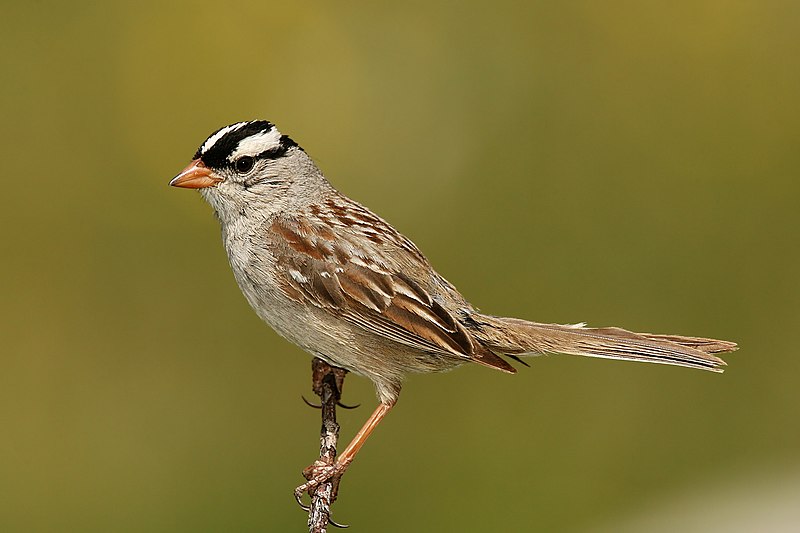
The White-crowned Sparrow is a species of passerine bird native to North America. It has a grey face and black and white streaking on its upper head, making it easy to identify.
This sparrow usually breeds in brushy areas located in the taiga, tundra, Rocky Mountains or Pacific coast regions of North America.
During winter months these birds migrate southward as far as Mexico and California where they can be found living amongst chaparral shrubbery or low bushes near open fields with plenty of seeds nearby.
The diet of this bird consists mainly of insects during summer while they switch over to eating grains like wheat & oats during colder months when bugs are scarce.
They are known for their characteristic chirp which sounds like “Oh sweet Canada Canada” drawing admirers from around the world.Scientific classification:
| Kingdom | Animalia |
| Phylum | Chordata |
| Class | Aves |
| Order | Passeriformes |
| Family | Passerellidae |
| Genus | Zonotrichia |
| Species | Z. leucophrys |
Also Featured In: Sparrows Species, Most Common Songs Birds that Live around You
39. Golden-Crowned Sparrow
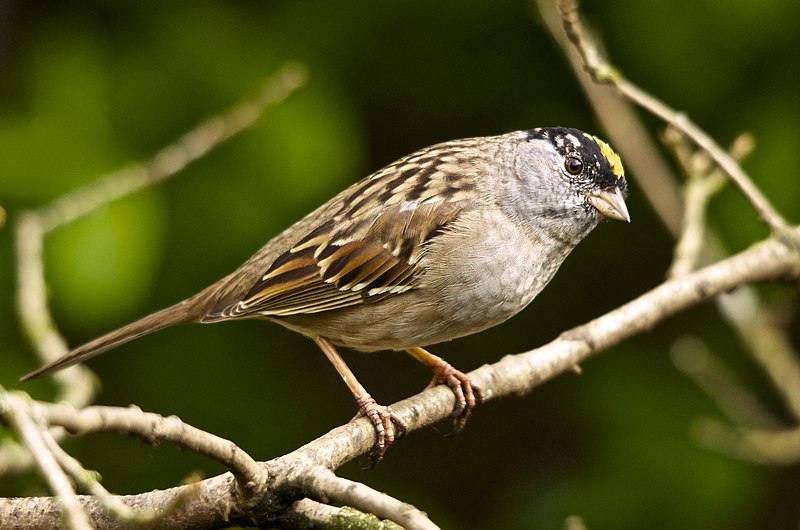
The golden-crowned sparrow is a large New World bird found in the western part of North America. It belongs to the genus Zonotrichia, made up of five species and has no subspecies.
This bird is closely related to the white-crowned sparrow as studies show their mitochondrial DNA evolves at a similar rate.
The most recognizable feature on this beautiful creature are its distinctive yellow stripes near its forehead that appear almost like an orange crown when seen from afar.
Its plumage can range from grey browns in winter months, to dull yellows and oranges during breeding season which typically occurs between April and July.
These birds are often seen foraging through leaf litter or along grassy fields looking for seeds, insects and berries to eat while they sing sweet melodies throughout their habitat.Scientific classification:
| Kingdom | Animalia |
| Phylum | Chordata |
| Class | Aves |
| Order | Passeriformes |
| Family | Passerellidae |
| Genus | Zonotrichia |
| Species | Z. atricapilla |
Also Featured In: Birds That Live around Seattle, Autumn Birds You Should Know
40. Cliff Swallow
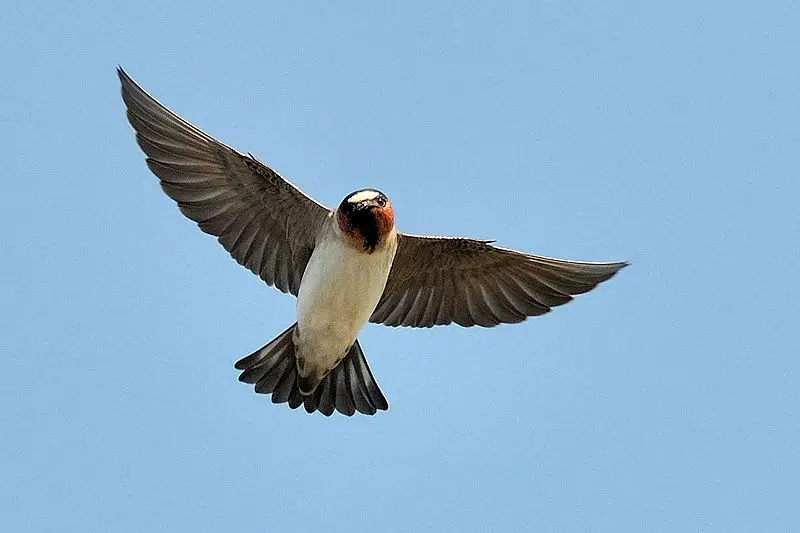
The Cliff swallow, or American cliff swallow (Petrochelidon pyrrhonota) is a species of passerine bird belonging to the family Hirundinidae. They are commonly found in North and South America.
These birds have an unmistakable appearance with their bright orange foreheads and flame-coloured backs that make them stand out from other swallows.
Cliff swallows form large colonies when nesting on cliffsides which makes them very social creatures; they often feed together while flying around fields or rivers looking for insects to eat.
In addition, they use mud pellets to build cup-shaped nests under bridges and eaves of buildings near water sources such as lakes, rivers and marshes – usually close by human dwellings.
Overall, these fascinating birds are both beautiful to look at yet practical too — providing insect pest control services through feeding on flies and mosquitoes in return for humans’ protection – what could be better?Scientific classification:
| Kingdom | Animalia |
| Phylum | Chordata |
| Class | Aves |
| Order | Passeriformes |
| Family | Hirundinidae |
| Genus | Petrochelidon |
| Species | P. pyrrhonota |
Also Featured In: Swallows Species, Blue Birds You’ll Found around Us
41. Nuttall’s Woodpecker
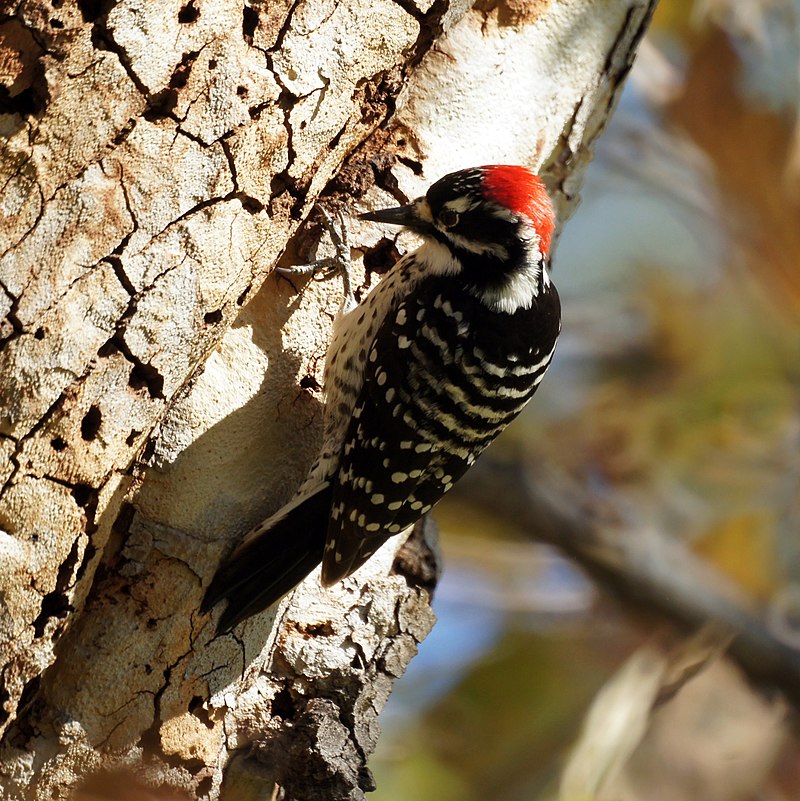
Nuttall’s woodpecker is a species of woodpecker named after naturalist Thomas Nuttall in 1843.
It is found mainly in oak woodlands of California and resembles the ladder-backed woodpecker genetically and physically.
The bird has black wings and tail feathers with white barring, as well as a white ventral surface decorated by small black spots.
They are quite distinct from other species due to their unique colouring; they have been known to hybridize successfully with red-naped sapsuckers when their habitats overlap.
While not considered threatened or endangered, these birds must be monitored closely to ensure that populations remain healthy across their range.Scientific classification:
| Kingdom | Animalia |
| Phylum | Chordata |
| Class | Aves |
| Order | Piciformes |
| Family | Picidae |
| Genus | Dryobates |
| Species | D. nuttallii |
Also Featured In: Woodpeckers Species, Spring Birds that Live around Us
42. California Scrub Jay
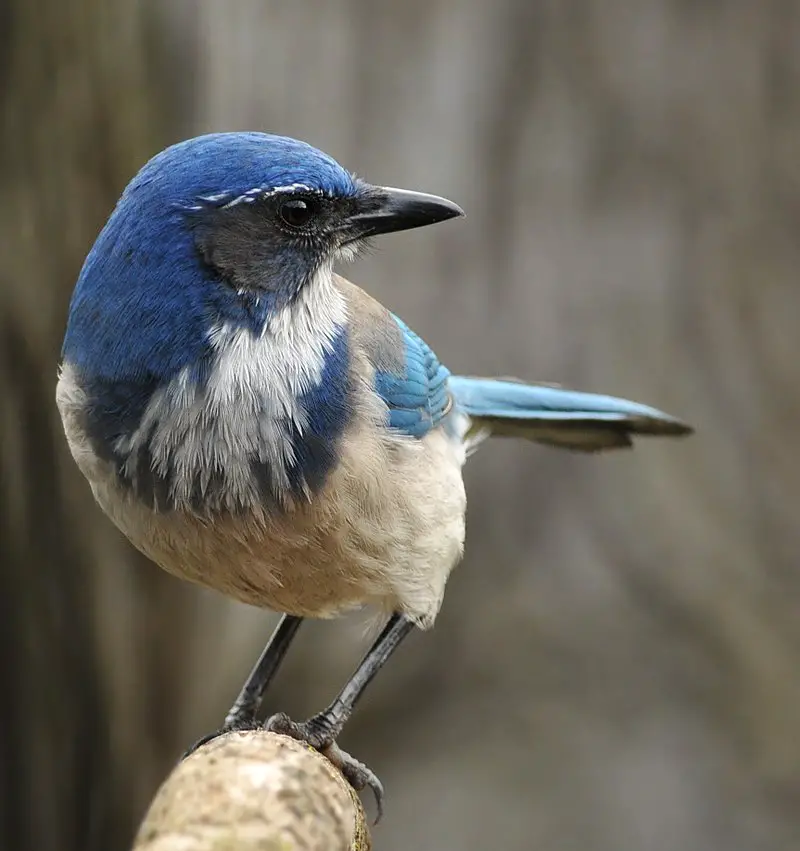
The California scrub jay is a species of bird native to western North America. It can be found from southern British Columbia all the way down through California and western Nevada near Reno, up to west beyond the Sierra Nevada range.
This beautiful blue feathered bird was once categorized with Woodhouse’s scrub jay as the “western scrub jay” along with island scrub jays.
The California Scrub Jay has distinctive features such as its greyish-blue feathers on its head, wings and tail; white cheeks; dark bill; and strong legs for perching in trees which makes it stand out among other birds in its family.Scientific classification:
| Kingdom | Animalia |
| Phylum | Chordata |
| Class | Aves |
| Order | Passeriformes |
| Family | Corvidae |
| Genus | Aphelocoma |
| Species | A. californica |
Also Featured In: Common Californian Birds, Summer Birds that Live around Us
43. California Towhee
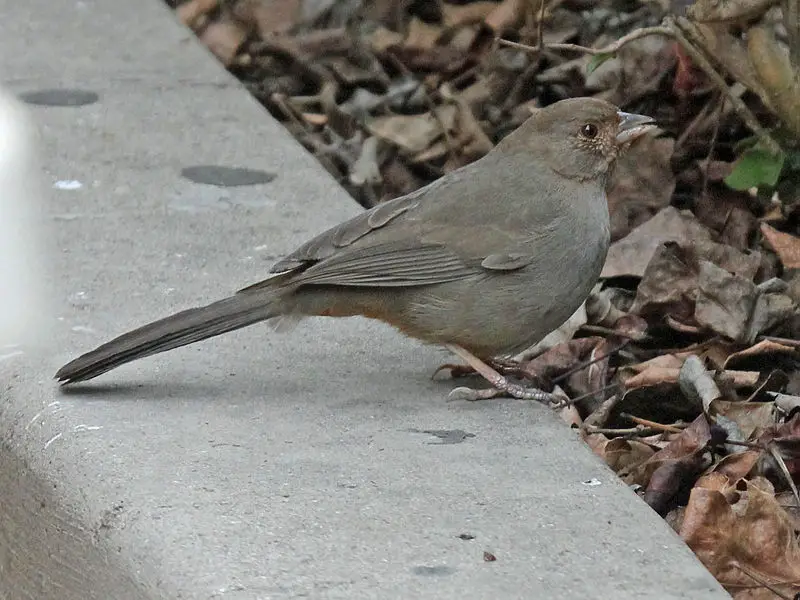
The California towhee (Melozone crissalis) is a medium-sized bird belonging to the family Passerellidae.
It can be found in coastal regions of Oregon, California and Baja California Sur in Mexico.
This species has been subject to taxonomic debate – some authors place it within Fringillidae instead.
The male Californian towhee are easily identified by their greyish brown plumage with black streaks on its back, tail and wings; while females have duller colors than males but still retain the same patterned feathering as them.
Additionally, they possess an orange-colored bill and legs which adds a pop of color to their otherwise dusky appearance.Scientific classification:
| Kingdom | Animalia |
| Phylum | Chordata |
| Class | Aves |
| Order | Passeriformes |
| Family | Passerellidae |
| Genus | Melozone |
| Species | M. crissalis |
Also Featured In: Birds that Live in Chaparral,
44. Snowy Plover

The Snowy Plover is a small wader bird, about 5-7″ in length. It breeds in the southern and western United States, the Caribbean, Ecuador, Peru and Chile.
Once thought to be a subspecies of the Kentish plover it has since been reclassified as its own species.
In order to protect nesting areas along Central California’s coastlines parts or entire beaches are closed off during breeding season for this endangered species.
This rare bird can easily be identified by its sandy brown color with white underbelly that helps camouflage itself from predators while on land but stands out when taking flight due to its brilliant white wingspan which provides an eye catching display against blue sky backdrop.Scientific classification:
| Kingdom | Animalia |
| Phylum | Chordata |
| Class | Aves |
| Order | Charadriiformes |
| Family | Charadriidae |
| Genus | Charadrius |
| Species | C. nivosus |
Also Featured In: Birds That Live In Gasparilla Island, Longboat Key Birds You Should Know
45. Western Snowy Plover
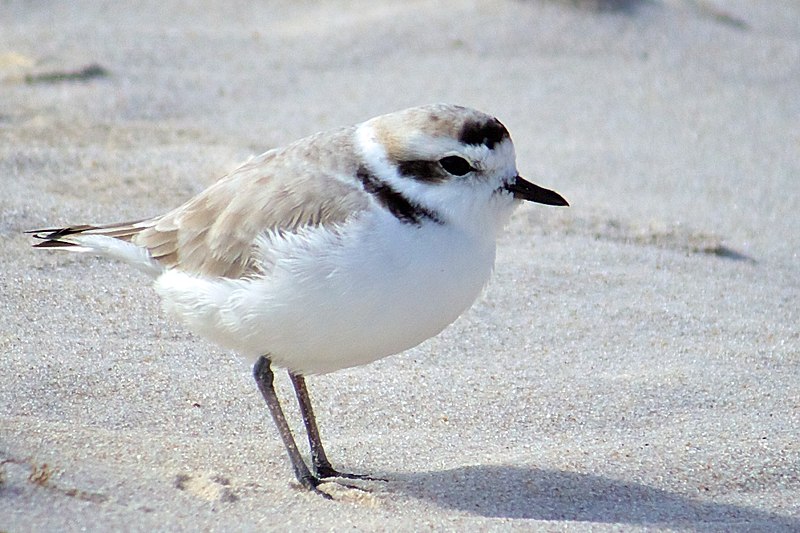
The western snowy plover is a small wader belonging to the plover bird family. It breeds in various areas of the United States and Caribbean, but its population has been decreasing over time due to habitat loss and other threats.
For this reason, on March 5th 1993 it was listed as threatened species under the Endangered Species Act of 1973.
In order to protect their habitats along California’s coast, Oregon’s coast and Washington’s coasts they have also been designated as critical habitats by The U.S Fish & Wildlife Service in 2012.
Conservation efforts are being taken for these birds including beach closures during nesting season; however more needs to be done if we want them safe from extinction. We must take action now before it’s too late.Scientific classification:
| Kingdom | Animalia |
| Phylum | Chordata |
| Class | Aves |
| Order | Charadriiformes |
| Family | Charadriidae |
| Genus | Charadrius |
| Species | C. nivosus |
| Subspecies | C. n. nivosus |
46. Steller’s Jay
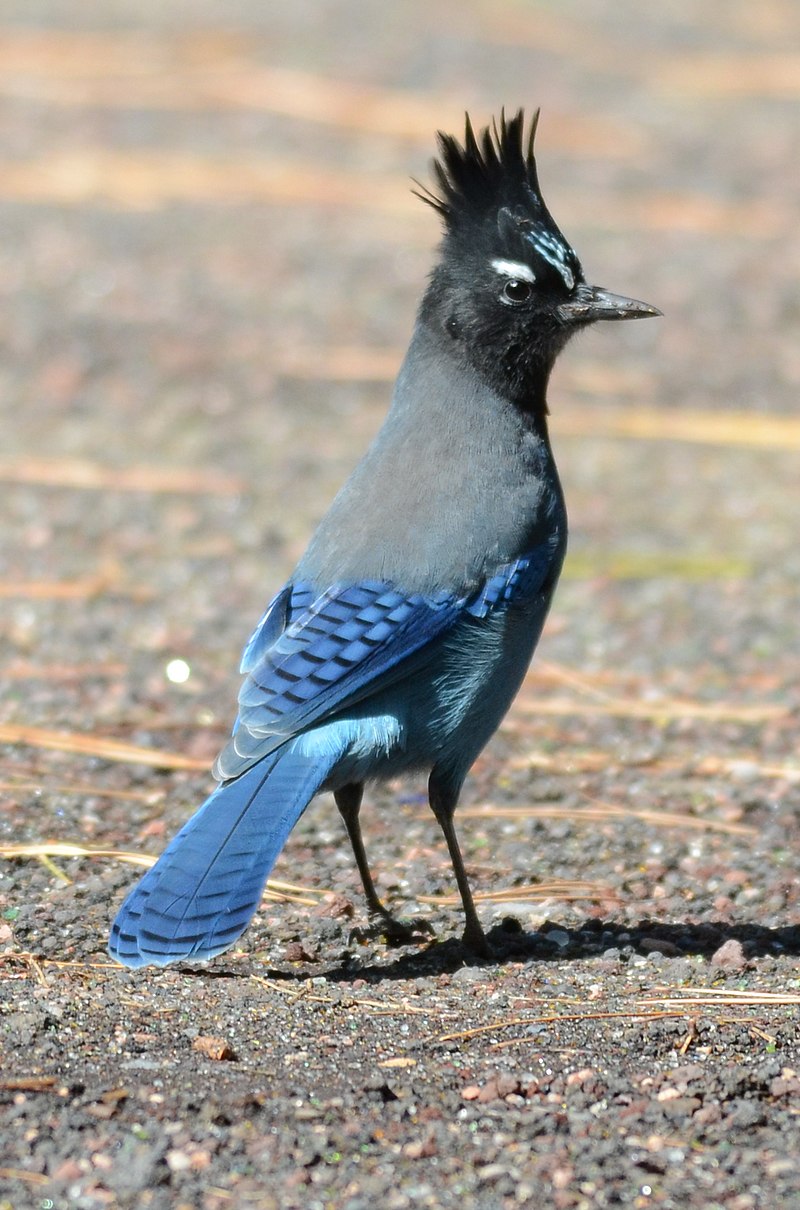
Steller’s jay is a beautiful and colorful bird native to western North America and the mountains of Central America.
It has a distinctive long crest that sets it apart from other birds, with its blue feathers streaked with black, white, gray, and brown markings.
This species is closely related to the blue jays found in eastern North America but can be distinguished by their longer crests.
They are known for being highly vocal birds who like to make loud calls throughout forests they inhabit as well as stealing food from unsuspecting mammals or raiding bird feeders when given the chance.
Steller’s Jays have adapted well to human presence in areas they populate making them great backyard visitors if you’re lucky enough.Scientific classification:
| Kingdom | Animalia |
| Phylum | Chordata |
| Class | Aves |
| Order | Passeriformes |
| Family | Corvidae |
| Genus | Cyanocitta |
| Species | C. stelleri |
Also Featured In: Alaska Birds, Birds that Live in Yosemite National Park
47. Brewer’s Blackbird
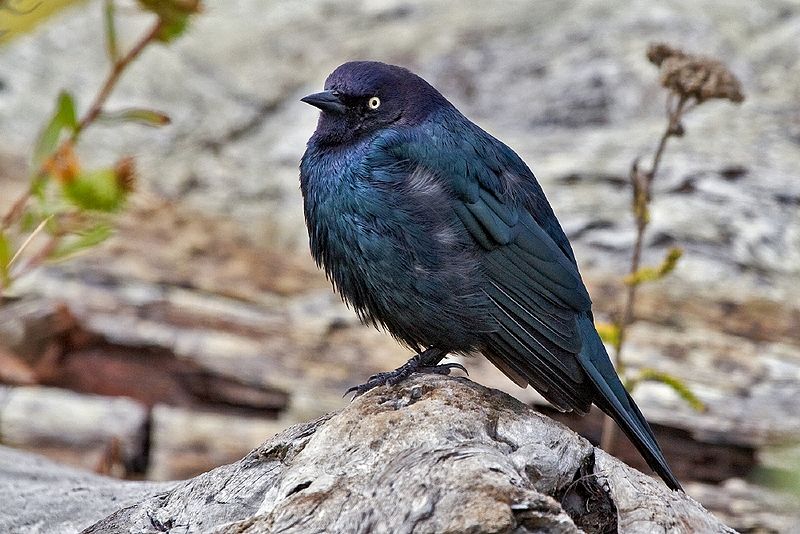
Brewer’s blackbird is a medium-sized New World bird that can be easily identified by its glossy, iridescent purple head and neck.
The body of the male has bluish-green highlights while females have brownish-grey plumage with slight hints of the male’s iridescence.
Both sexes possess bright yellow eyes, black feet and legs, and dark wings. Brewer’s blackbirds are commonly found in open grasslands or shrubland habitats.
They prefer to eat insects but will also feed on grains such as wheat or corn if available during winter months when insect populations decline.
These birds often form large flocks which provide protection from predators like hawks or owls looking for an easy meal.Scientific classification:
| Kingdom | Animalia |
| Phylum | Chordata |
| Class | Aves |
| Order | Passeriformes |
| Family | Icteridae |
| Genus | Euphagus |
| Species | E. cyanocephalus |
Also Featured In: birds of Idaho, Blue Birds that You’ll Find in Utah
48. Brown Pelican

The majestic brown pelican is a dive-feeding bird that belongs to the pelican family. It is one of the three pelican species found in the Americas and is known to dive into water to catch its prey.
From the Atlantic Coast of New Jersey to the mouth of the Amazon River, and along the Pacific Coast from British Columbia to northern Chile, including the Galapagos Islands, this bird can be found.
Its scientific name is Pelecanus occidentalis, and it has a colored brown plumage, which is its distinct characteristic.
The brown pelican belongs to the largest bird species that exist today, with a wingspan that can stretch up to seven feet long.
This bird helps maintain a balance in the ecosystem by eating smaller fish, crustaceans, and other aquatic prey.Scientific classification:
| Kingdom | Animalia |
| Phylum | Chordata |
| Class | Aves |
| Order | Pelecaniformes |
| Family | Pelecanidae |
| Genus | Pelecanus |
| Species | P. occidentalis |
Also Featured In: Flight Birds You Should Know, Galapagos Birds You Should Know
49. Cedar Waxwing
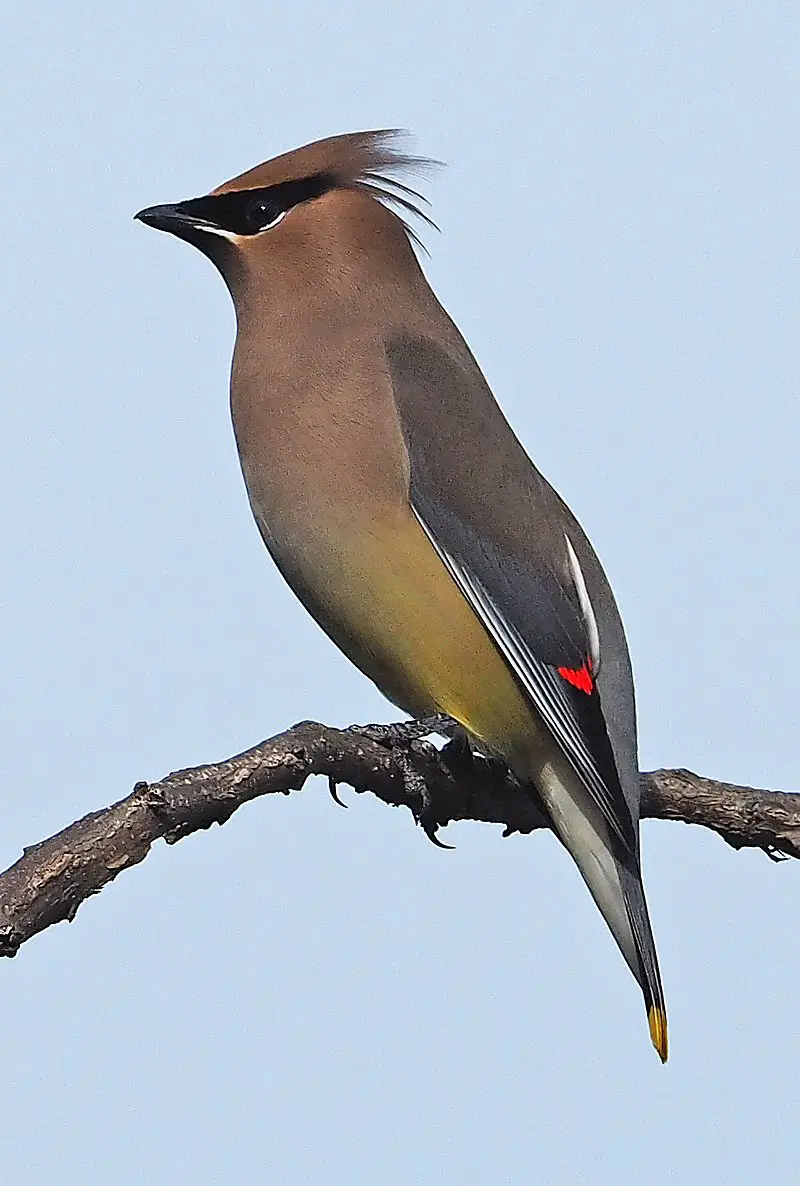
The Cedar waxwing, also known as Bombycilla cedrorum, is a medium-sized bird found in North and Central America.
They have a mixture of brown, gray and yellow feathers on their body, and their wings have wax-like tips.
These birds prefer open wooded areas in Southern Canada for breeding, and during winter, they migrate to the Southern part of the United States, Central America, and the far.
The Cedar waxwing is a member of the waxwing family of birds or Bombycillidae family.
They are known for their distinctive crest on their head and a black mask-like area around their eyes.
These birds are social creatures and can often be seen in large flocks, sometimes even intermixing with other bird species.
Their diet consists mainly of fruit and insects, and they are important dispersers of fruit seeds.
The Cedar waxwing bird is a beautiful and fascinating creature to observe in the wild.Scientific classification:
| Kingdom | Animalia |
| Phylum | Chordata |
| Class | Aves |
| Order | Passeriformes |
| Family | Bombycillidae |
| Genus | Bombycilla |
| Species | B. cedrorum |
Also Featured In: Birds Commonly Found in New York, Birds Live in Arkansas
50. Red-Shouldered Hawk
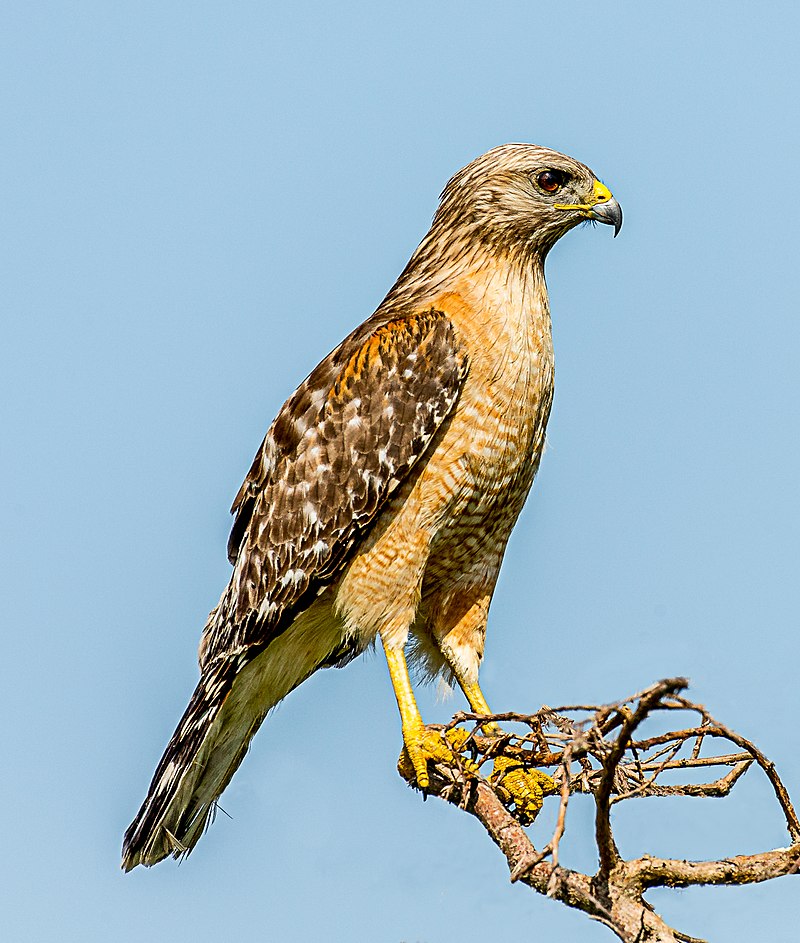
The red-shouldered hawk, also known as Buteo lineatus, is a medium-sized bird of prey found in eastern North America and along the coast of California and northern to northeastern-central Mexico.
While many of these hawks are permanent residents within their range, northern populations do migrate, with most traveling to central Mexico.
The species faces numerous threats to its survival, with deforestation being a primary issue.
Despite the many challenges they face, these birds are an important part of their ecosystems, primarily feeding on rodents, small mammals, and amphibians.
In addition to their hunting capabilities, these hawks are known for their striking appearance, featuring reddish brown shoulder feathers and bold black and white striped wings.
Overall, the red-shouldered hawk is a fascinating and important bird that plays a vital role in its surroundings.Scientific classification:
| Kingdom | Animalia |
| Phylum | Chordata |
| Class | Aves |
| Order | Accipitriformes |
| Family | Accipitridae |
| Genus | Buteo |
| Species | B. lineatus |
Also Featured In: Birds You’ll Find in South Texas , Common Carnivore Birds
51. Western Sandpiper
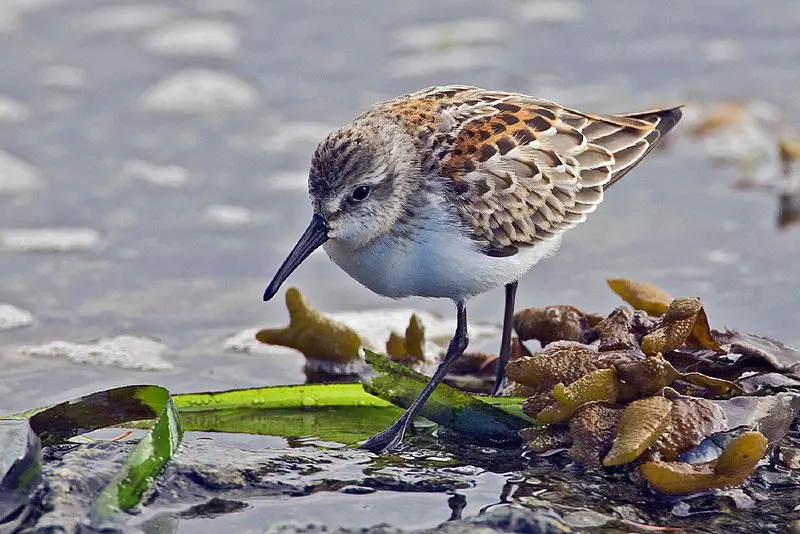
The Western sandpiper is a small shorebird found in North America. Its genus name, Kalidris, comes from the Ancient Greek term used by Aristotle for some grey-colored waterside birds.
The species name, mauri, is named after Italian botanist Ernesto Mauri. This species is one of the most abundant shorebirds in North America, with a population in the millions. Western sandpipers have dark legs and a short, straight bill.
They are often seen running quickly along the shorelines, probing the sand for insects and small crustaceans.
During breeding season, they nest in the Arctic tundra, and during migration, they can be found on mudflats and beaches along the Pacific Coast as well as inland shallow freshwater wetlands.Scientific classification:
| Kingdom | Animalia |
| Phylum | Chordata |
| Class | Aves |
| Order | Charadriiformes |
| Family | Scolopacidae |
| Genus | Calidris |
| Species | C. mauri |
Also Featured In: Birds in Pacific Northwest, Most Common Oaxaca Birds